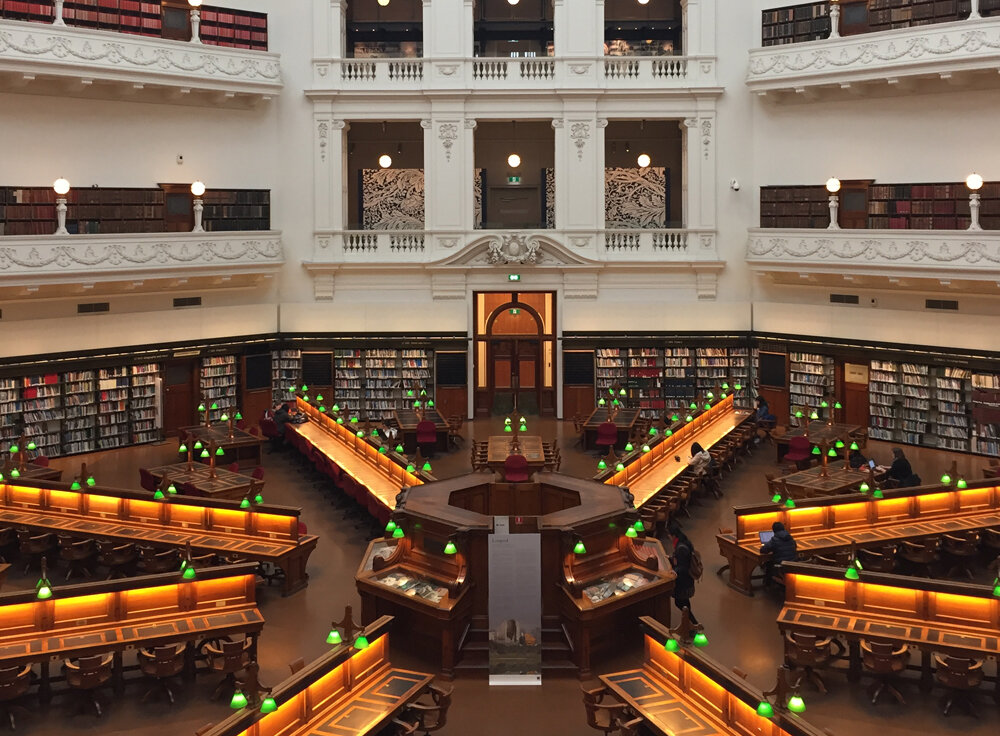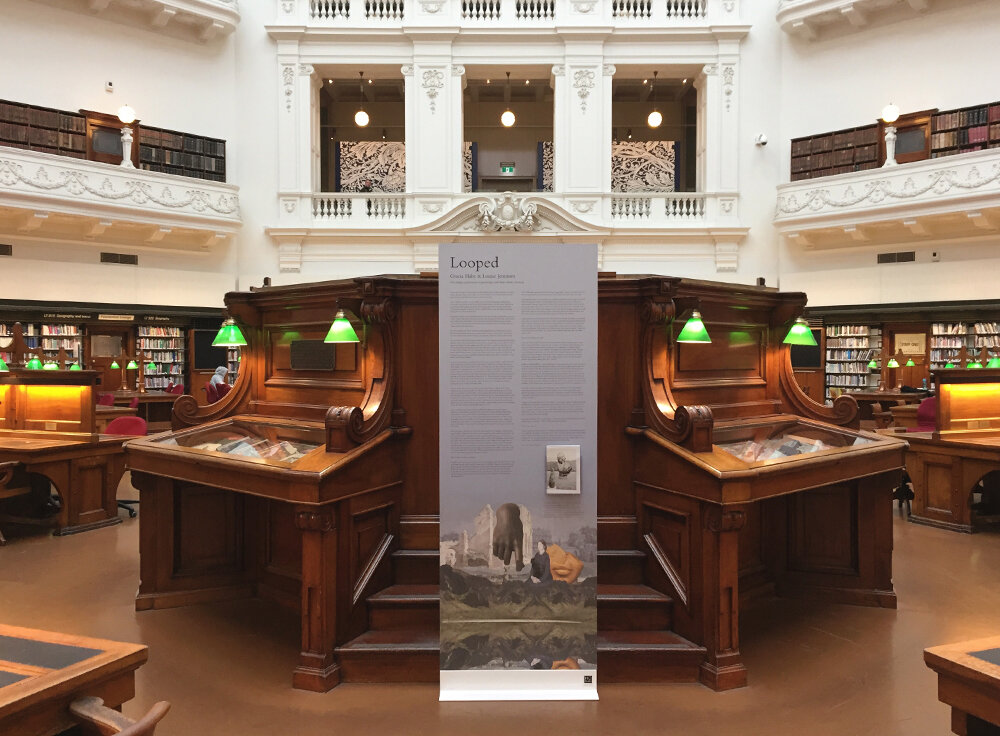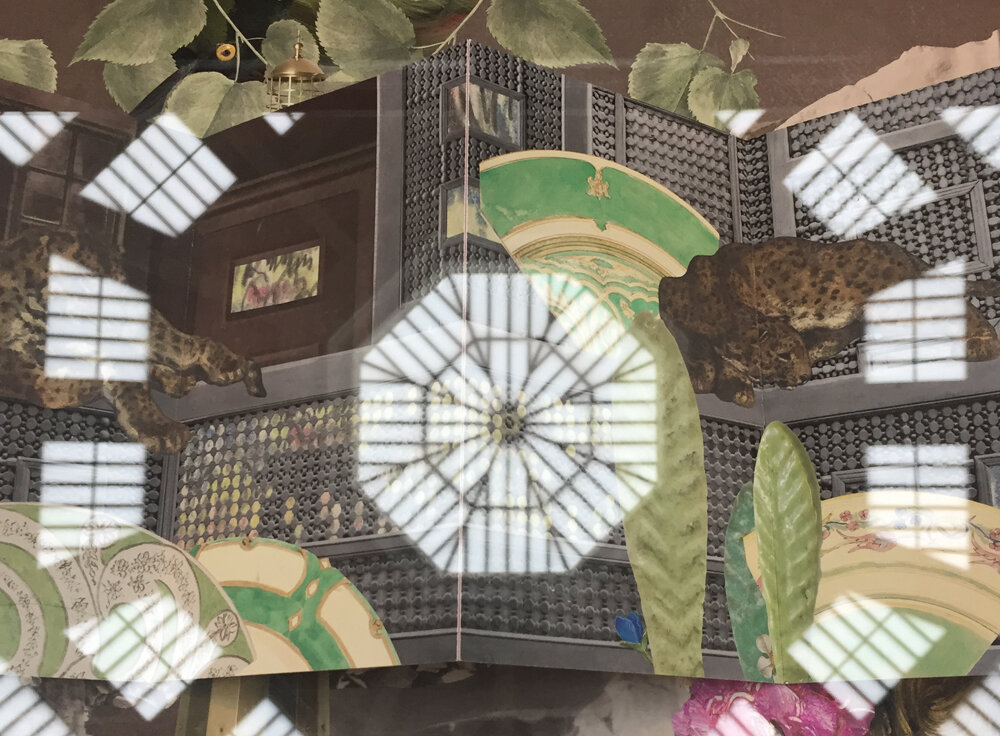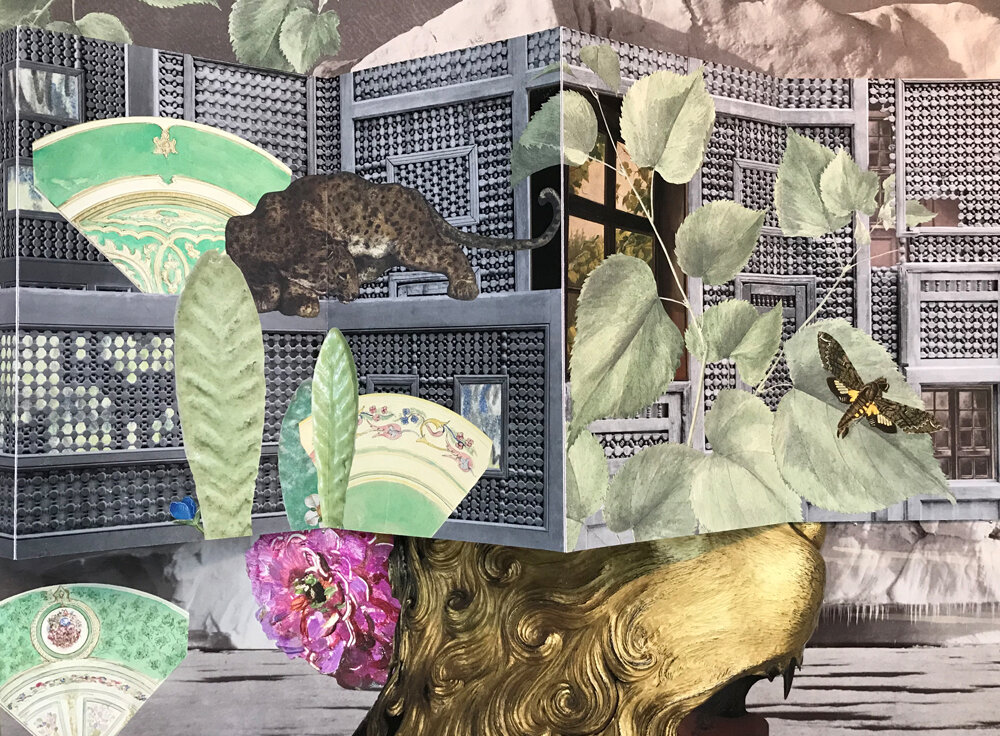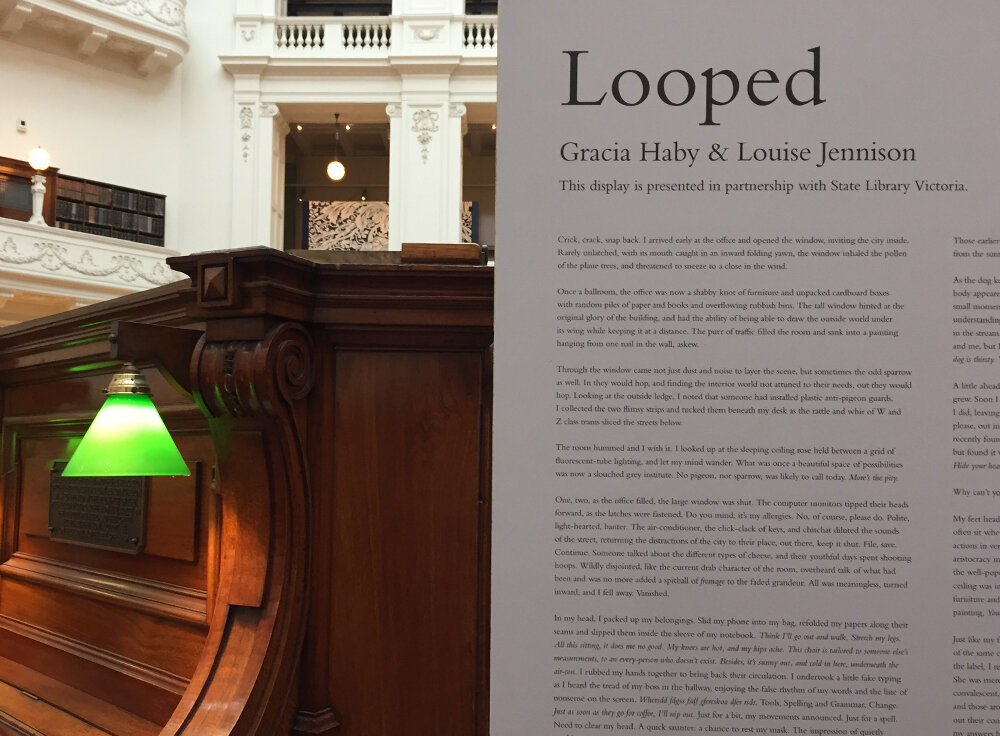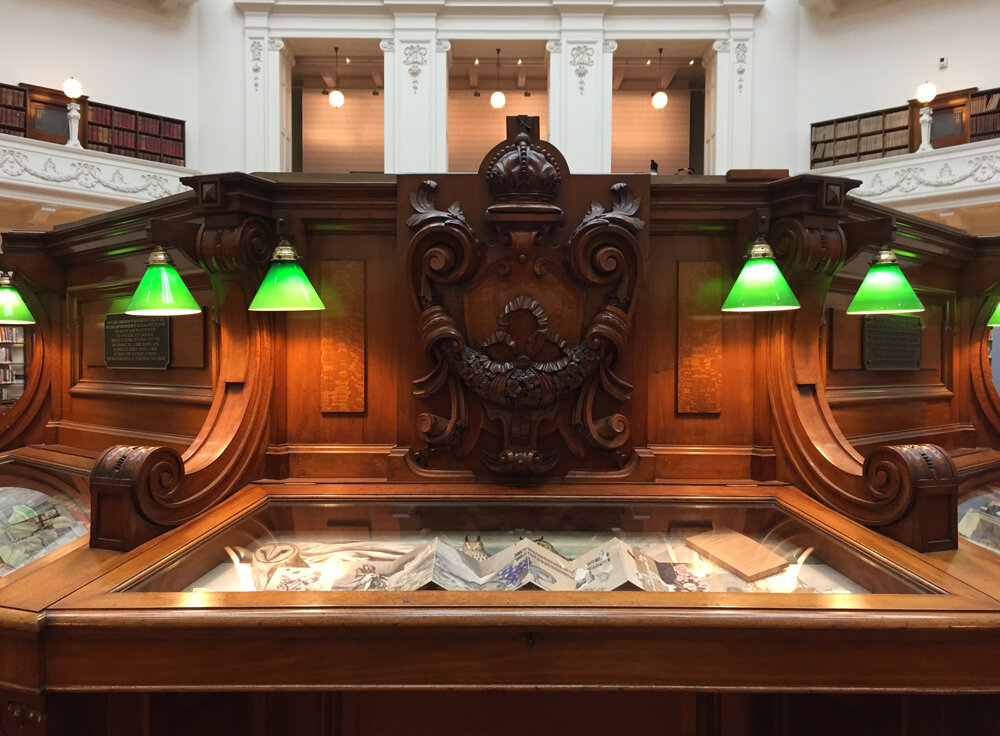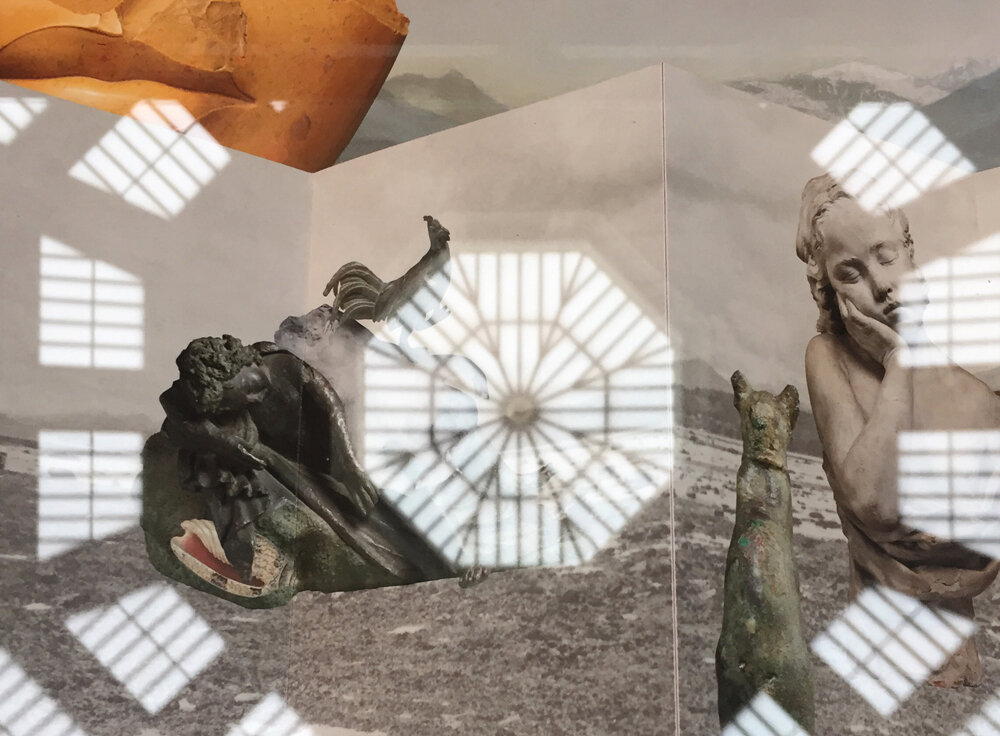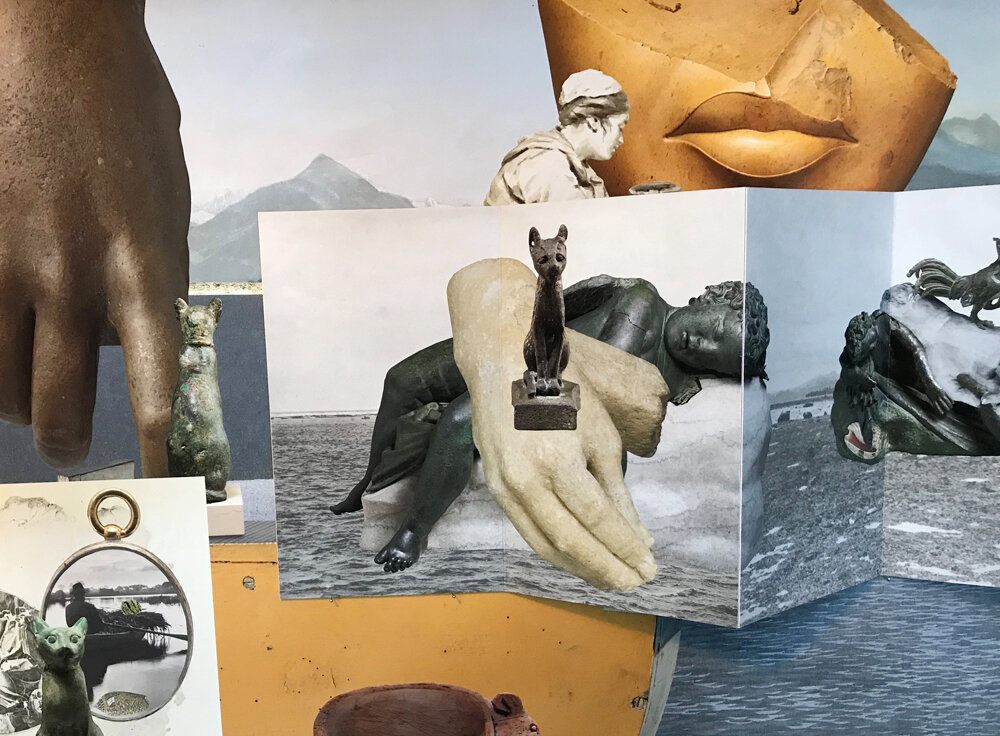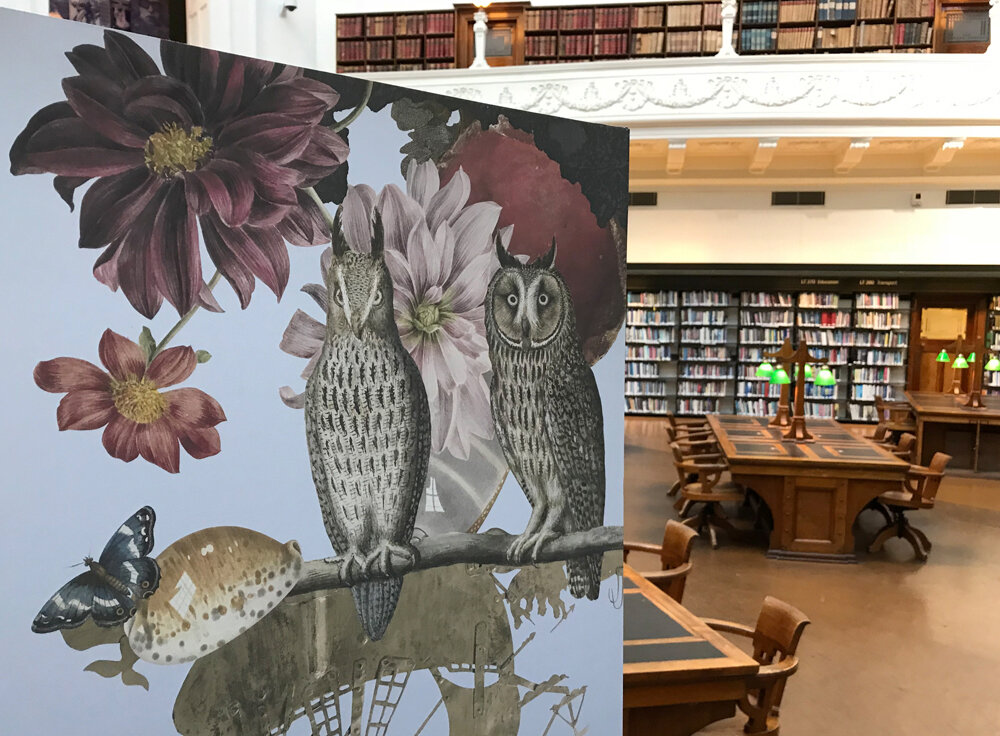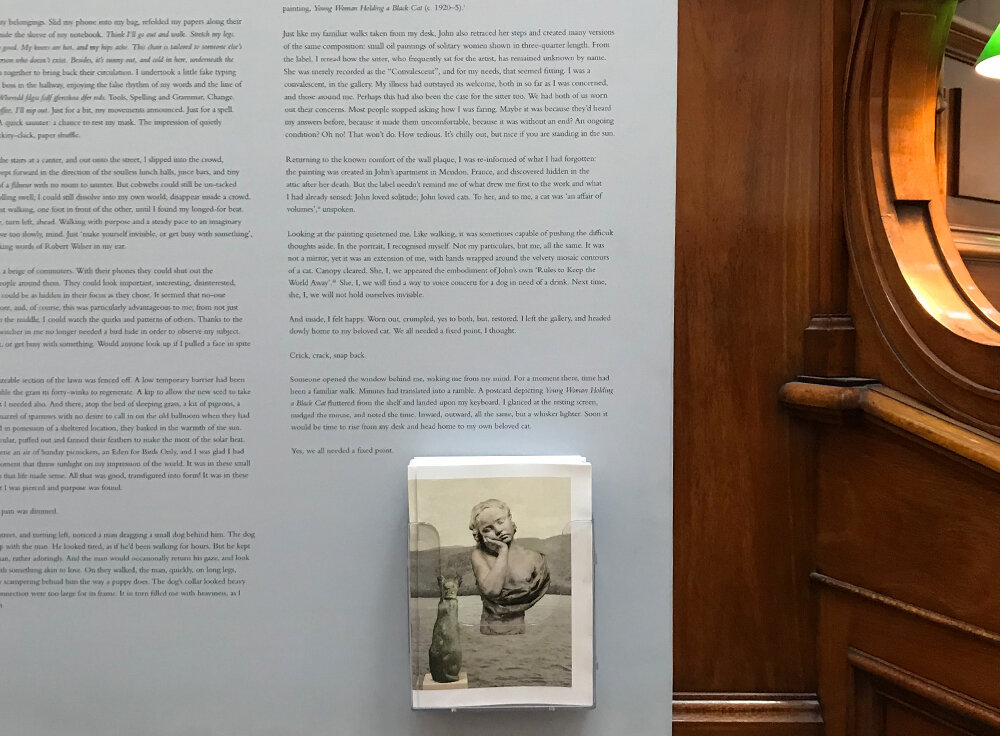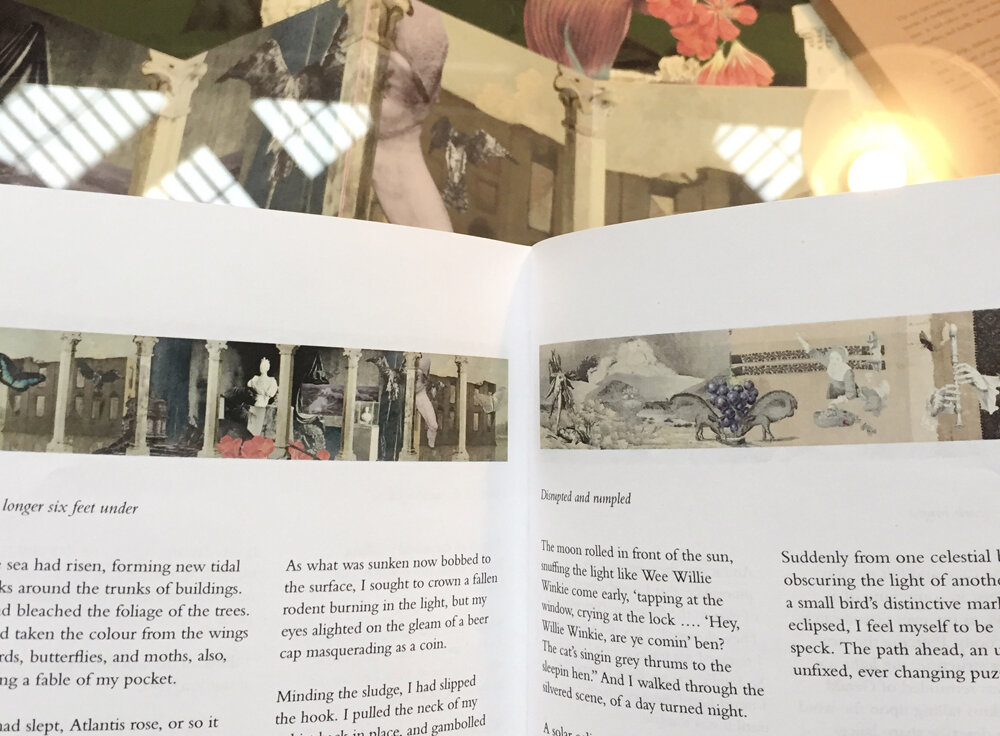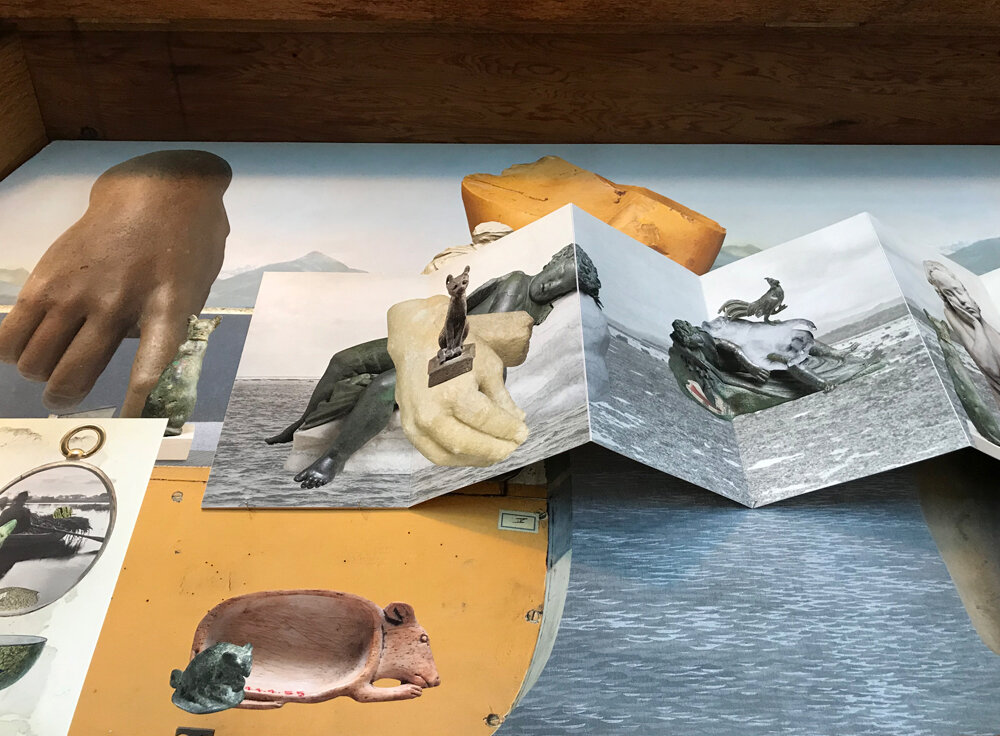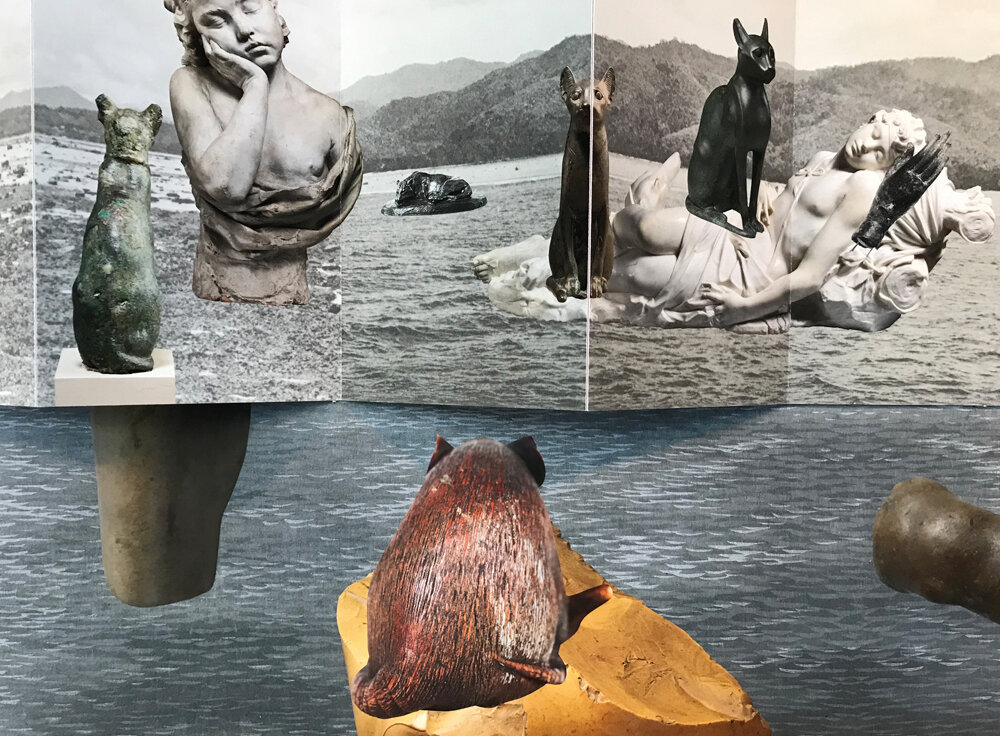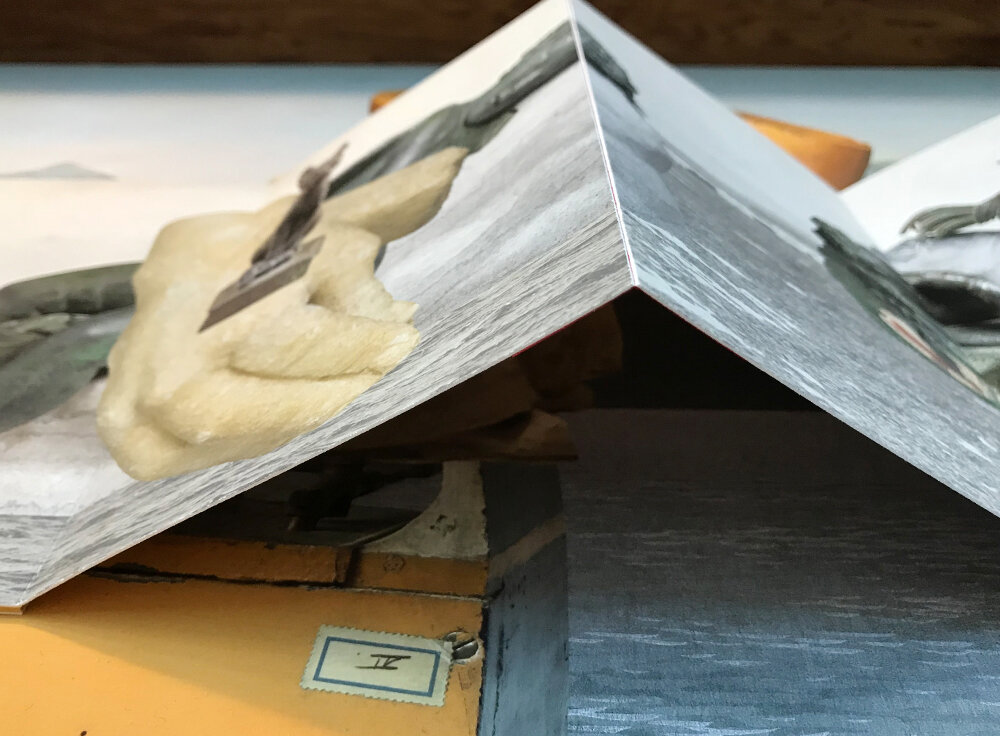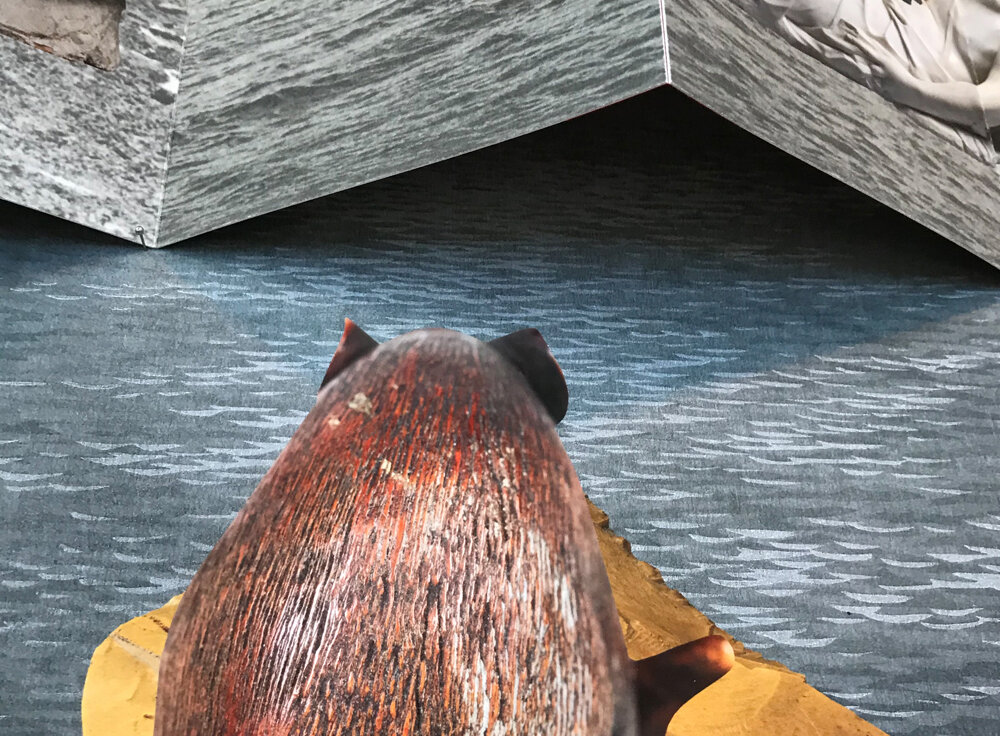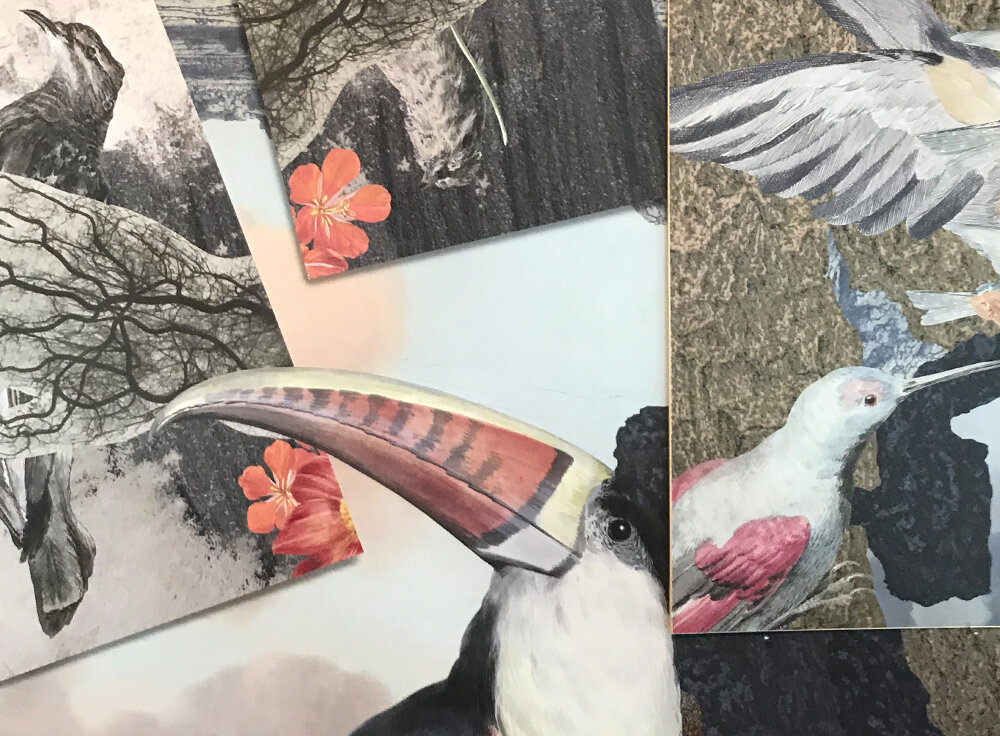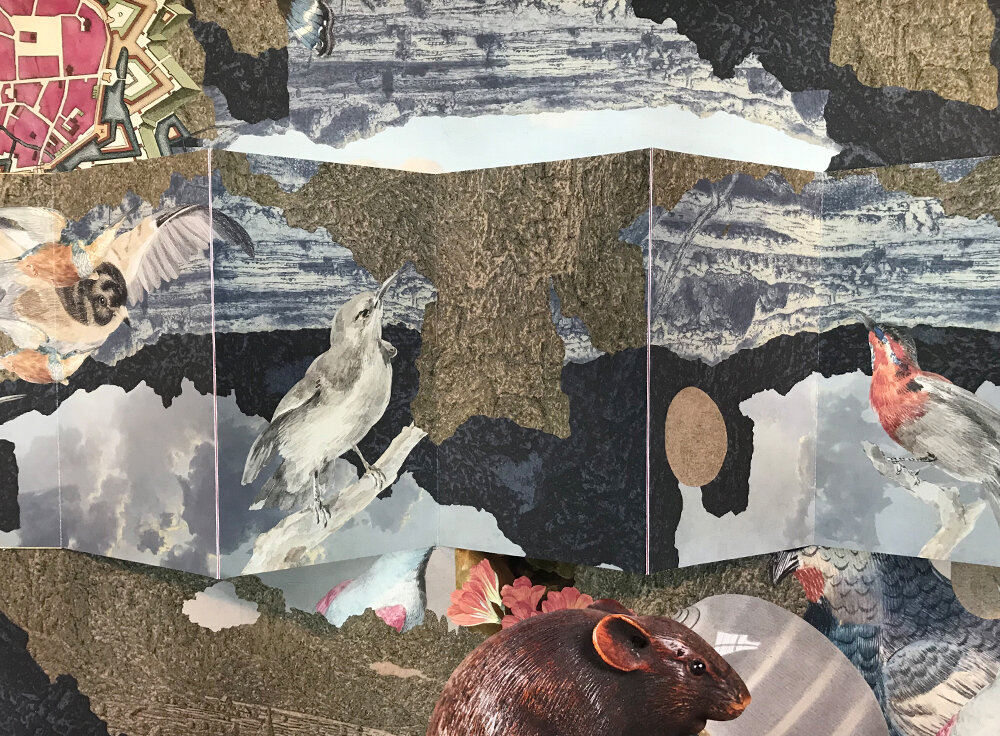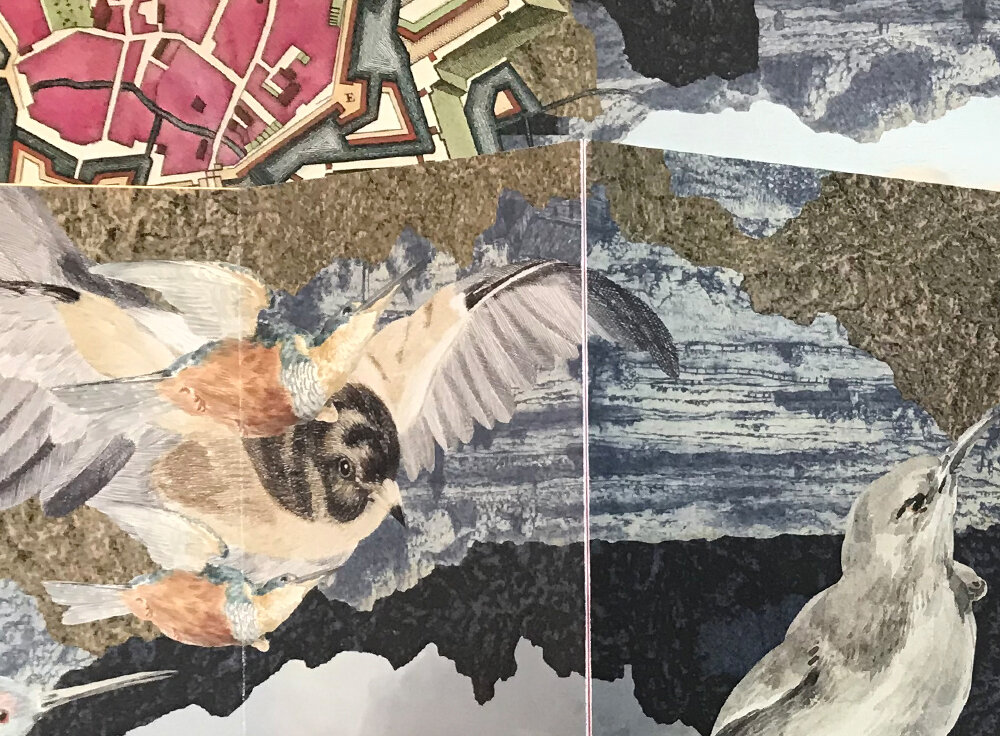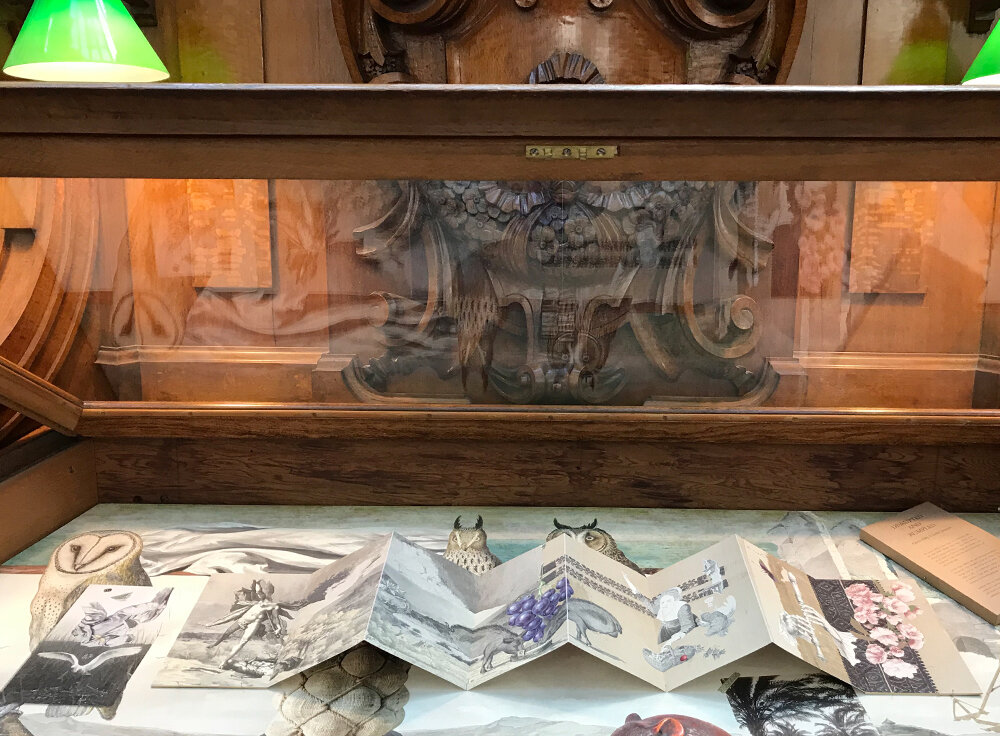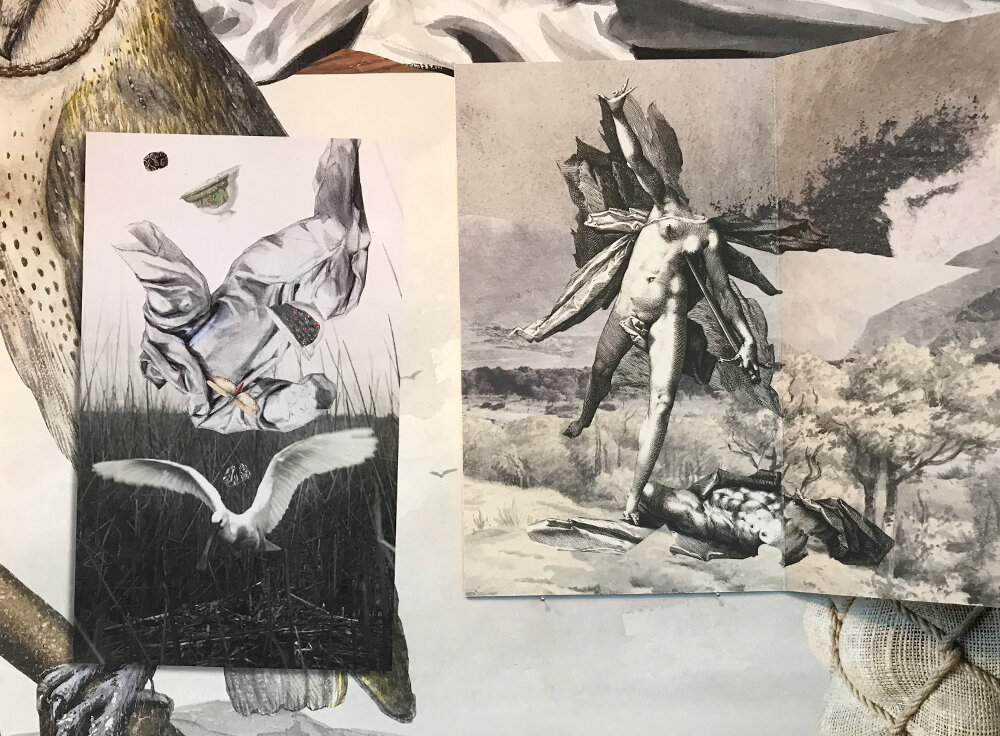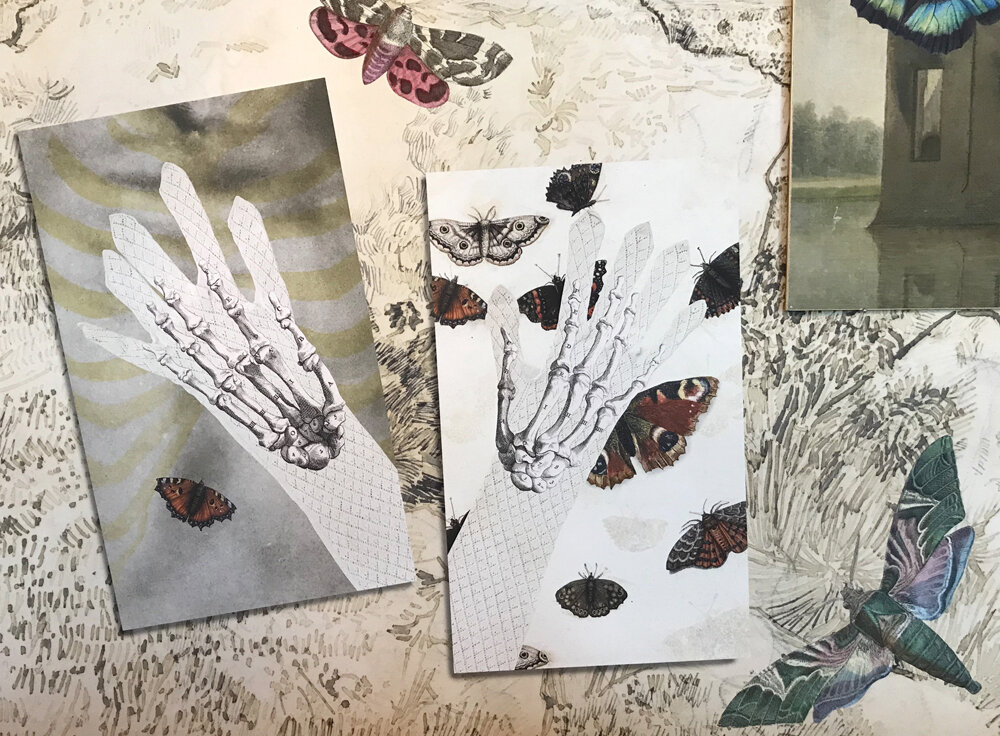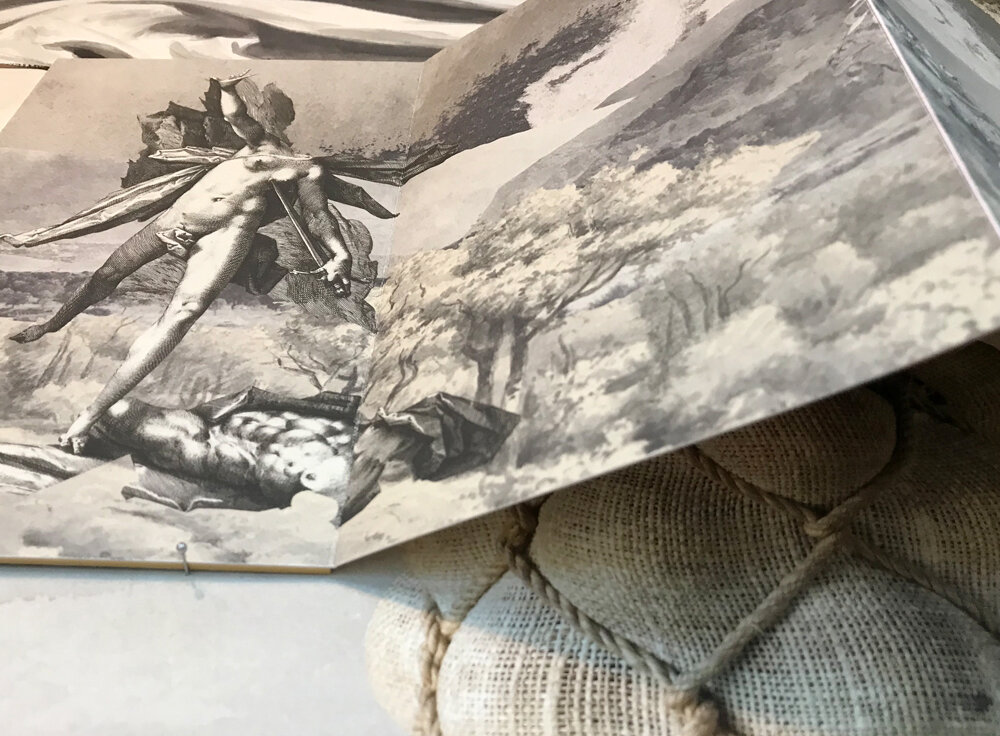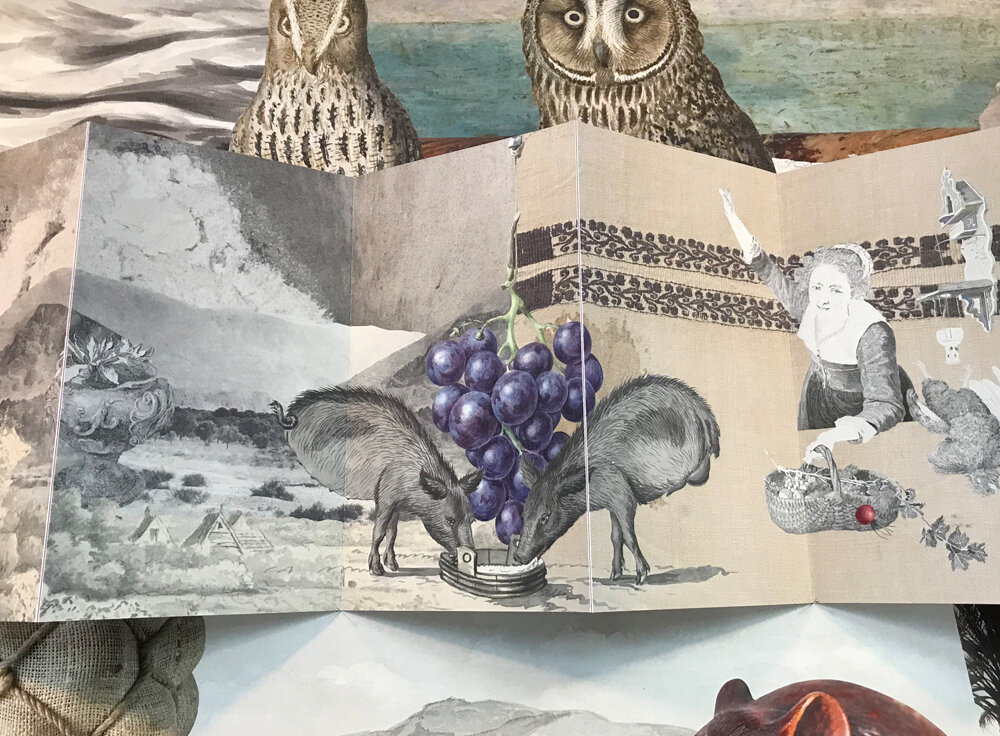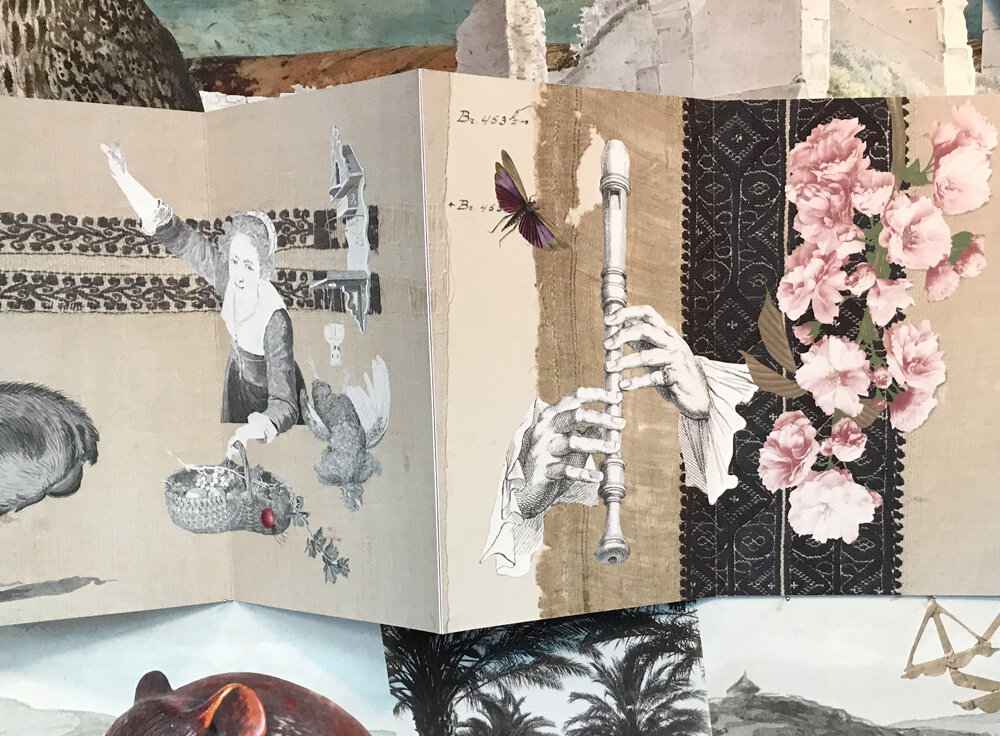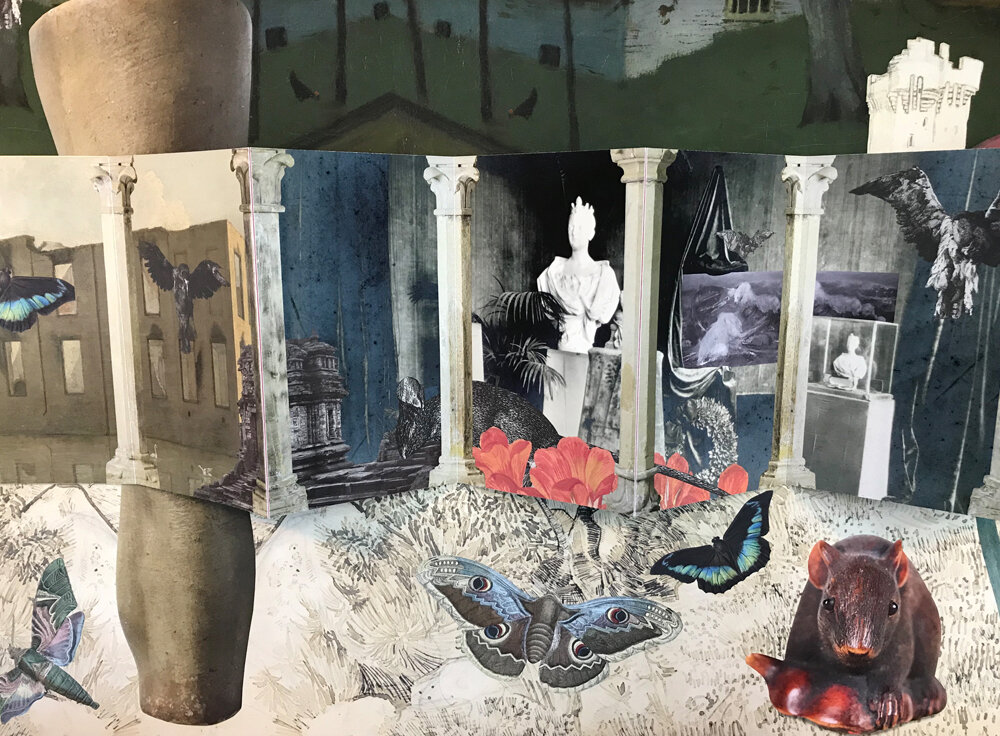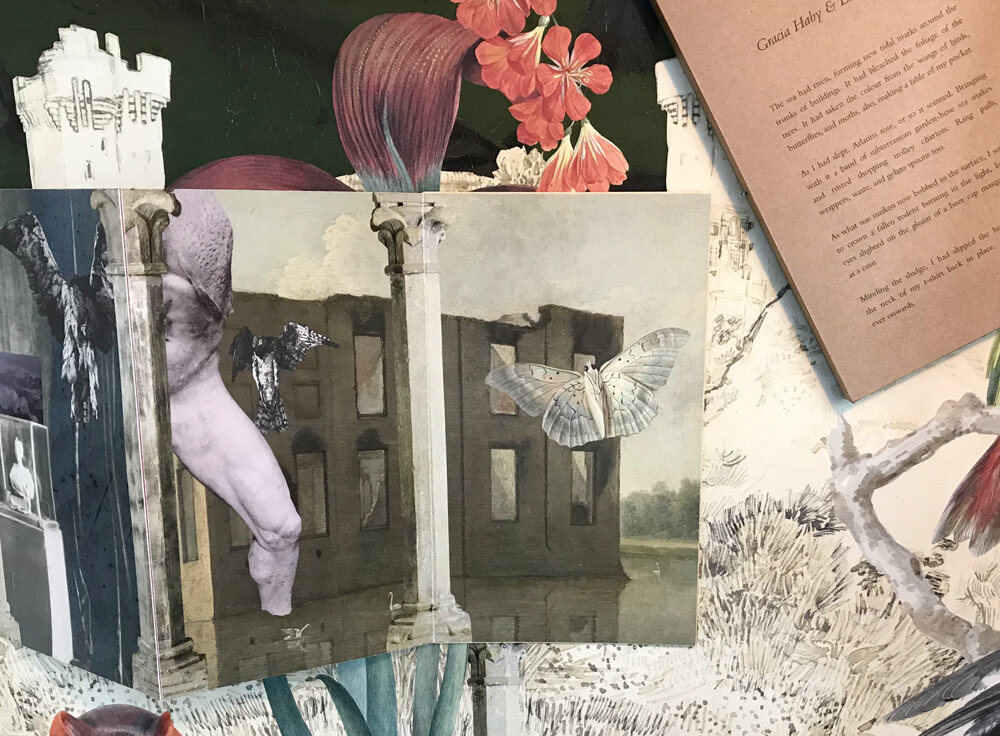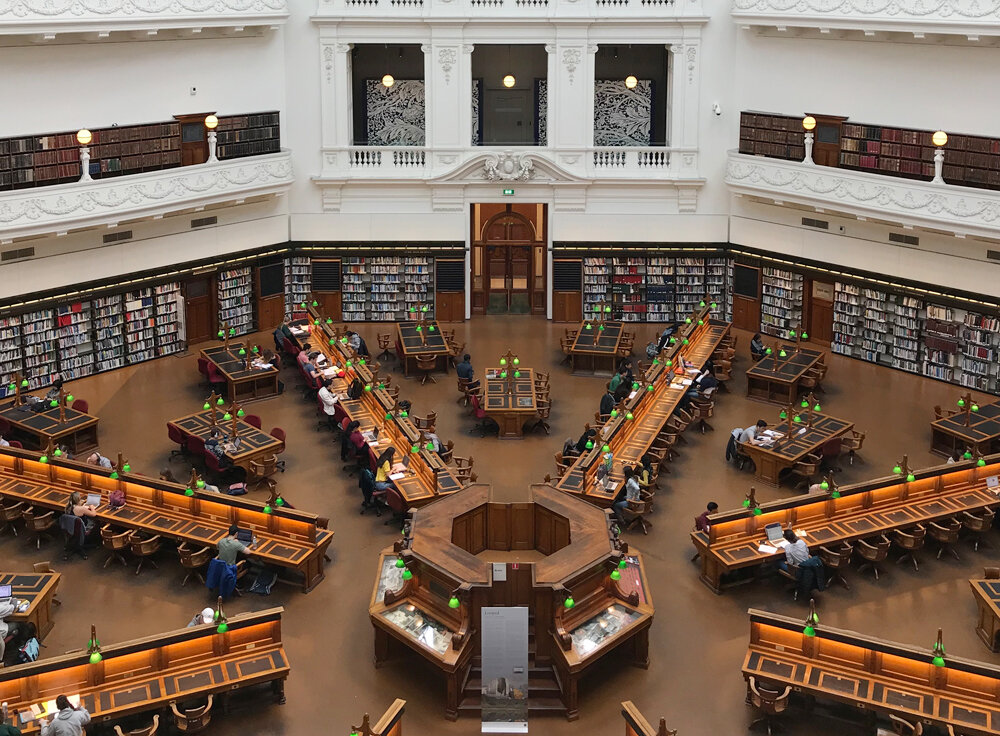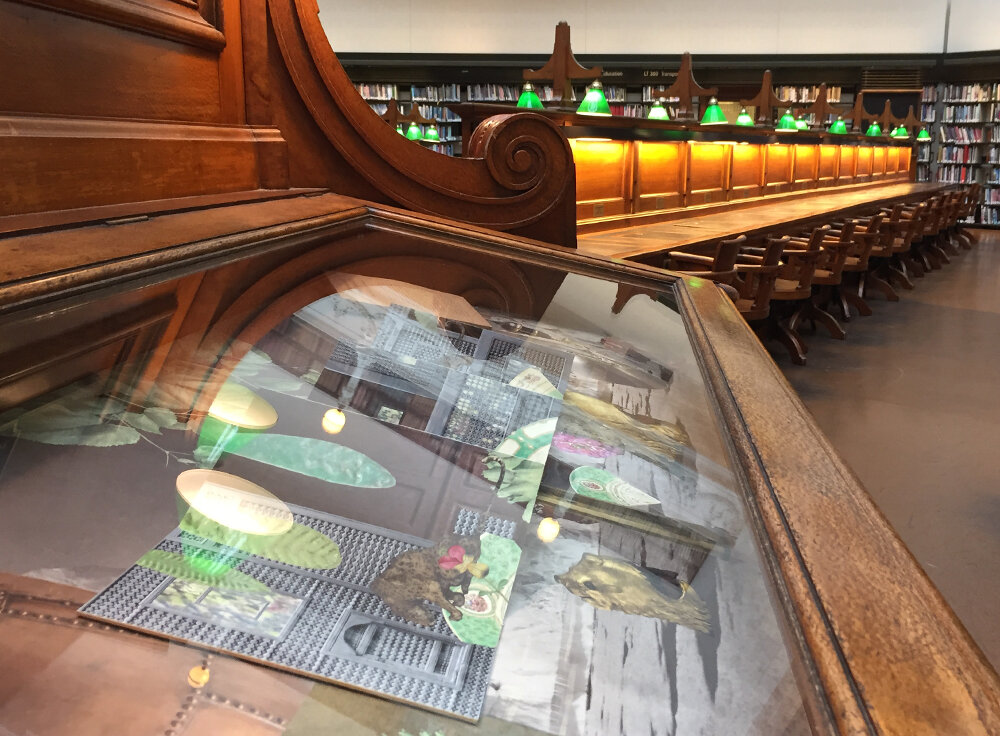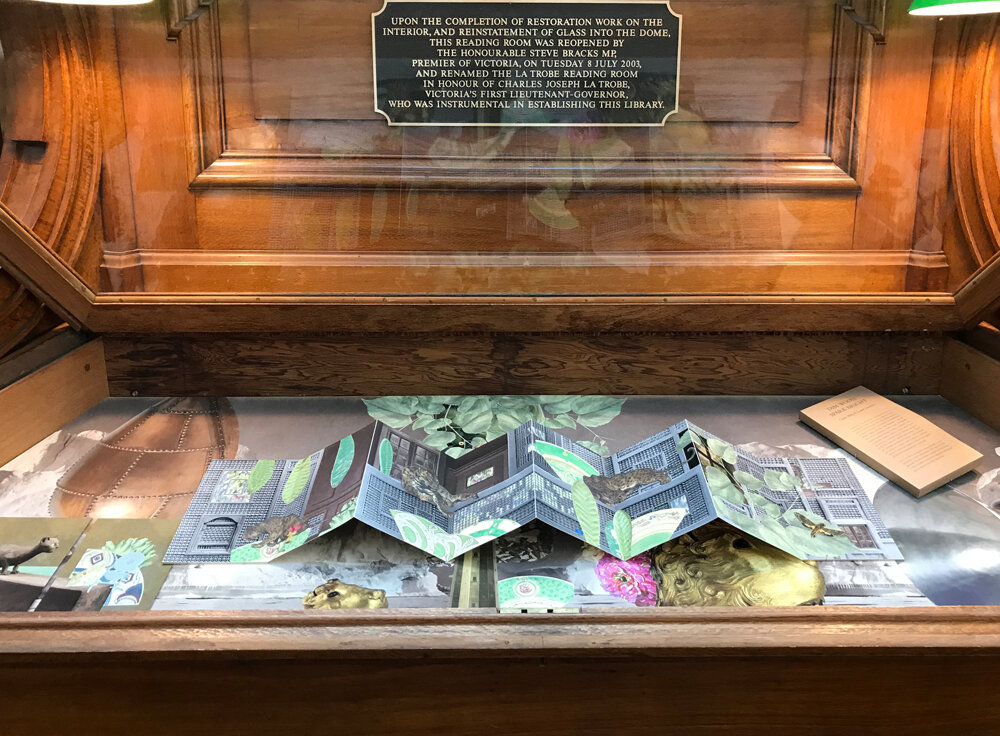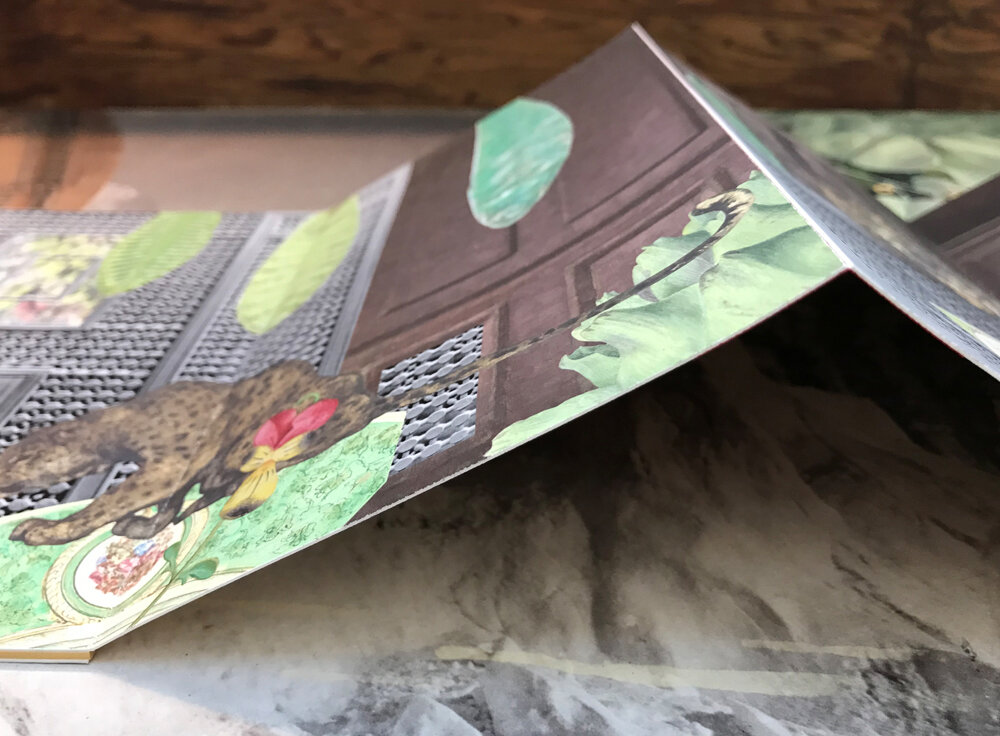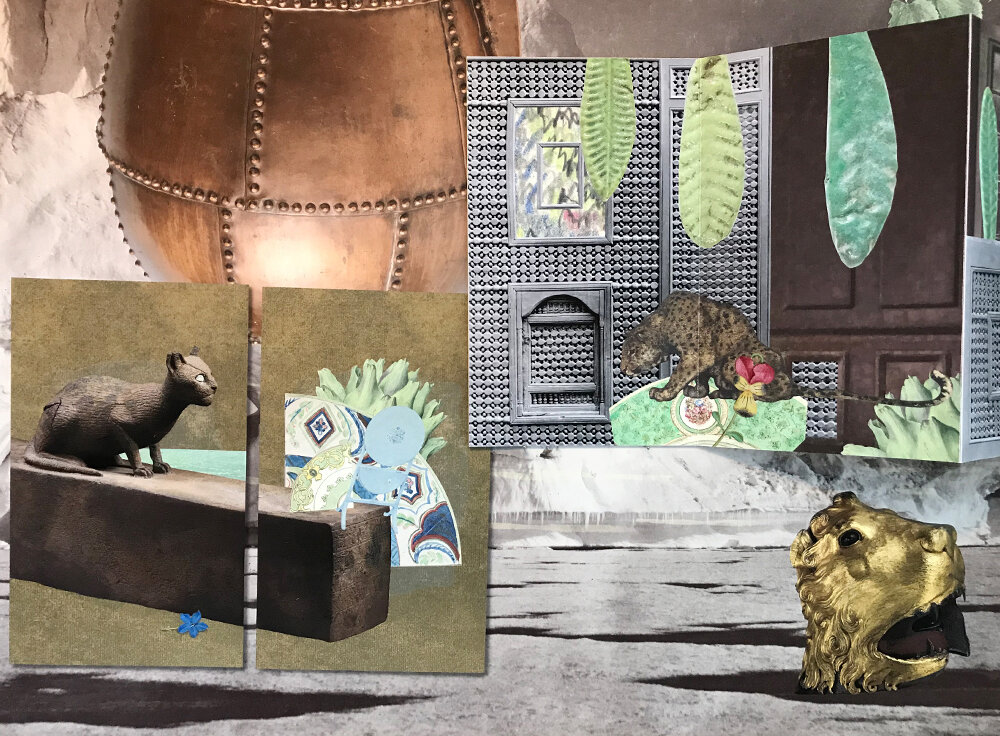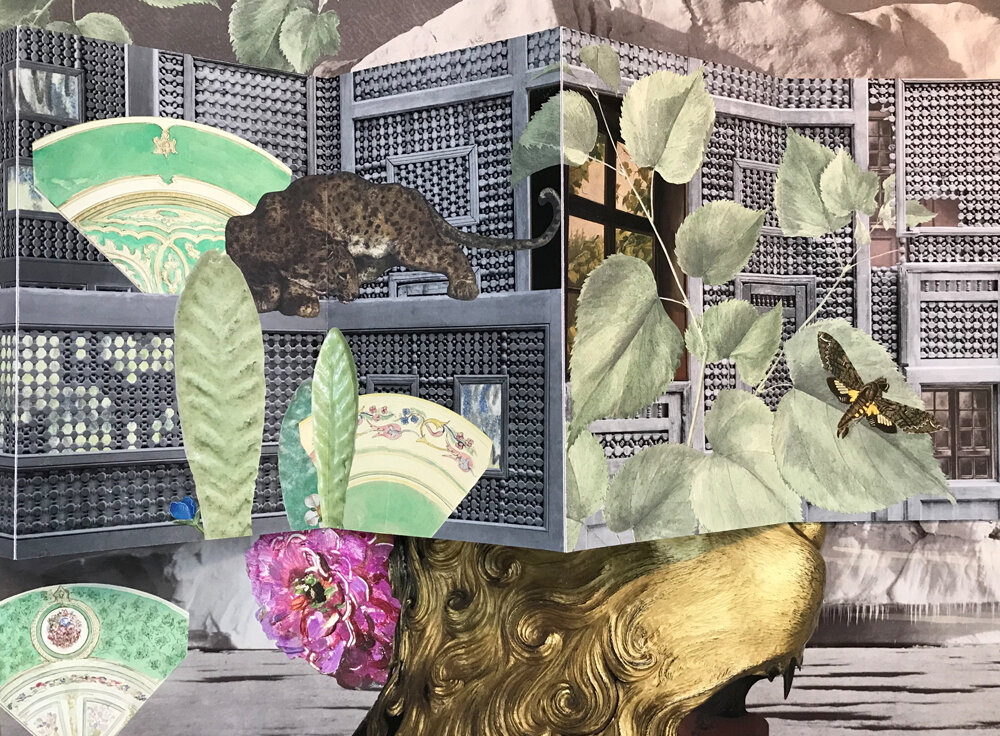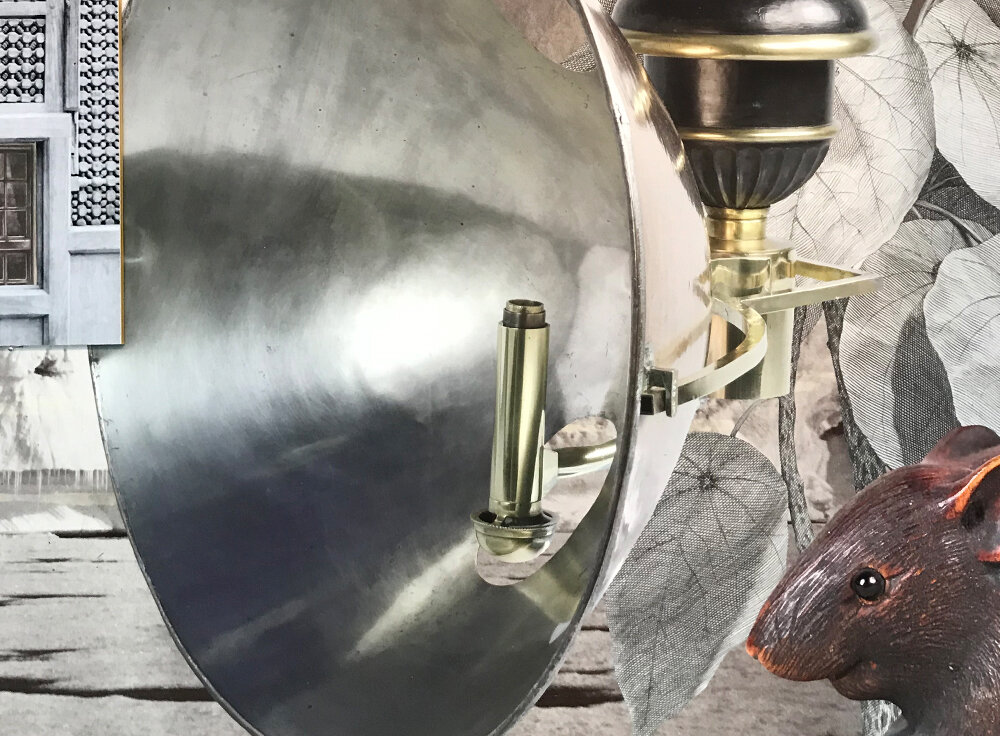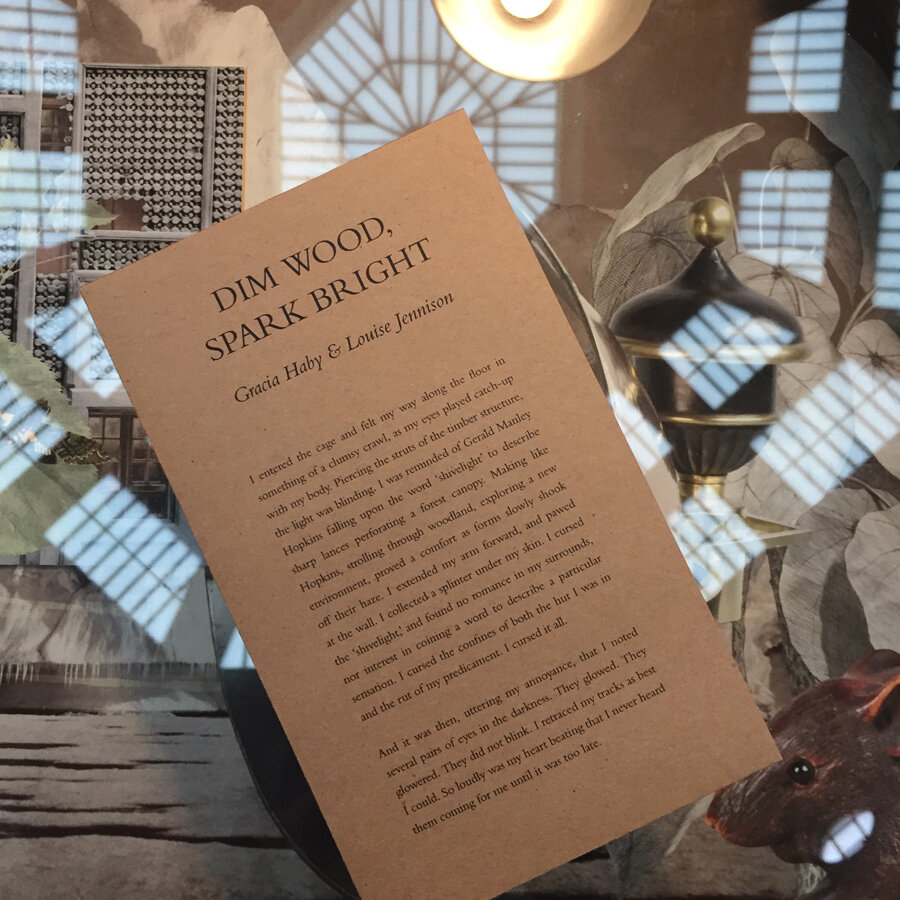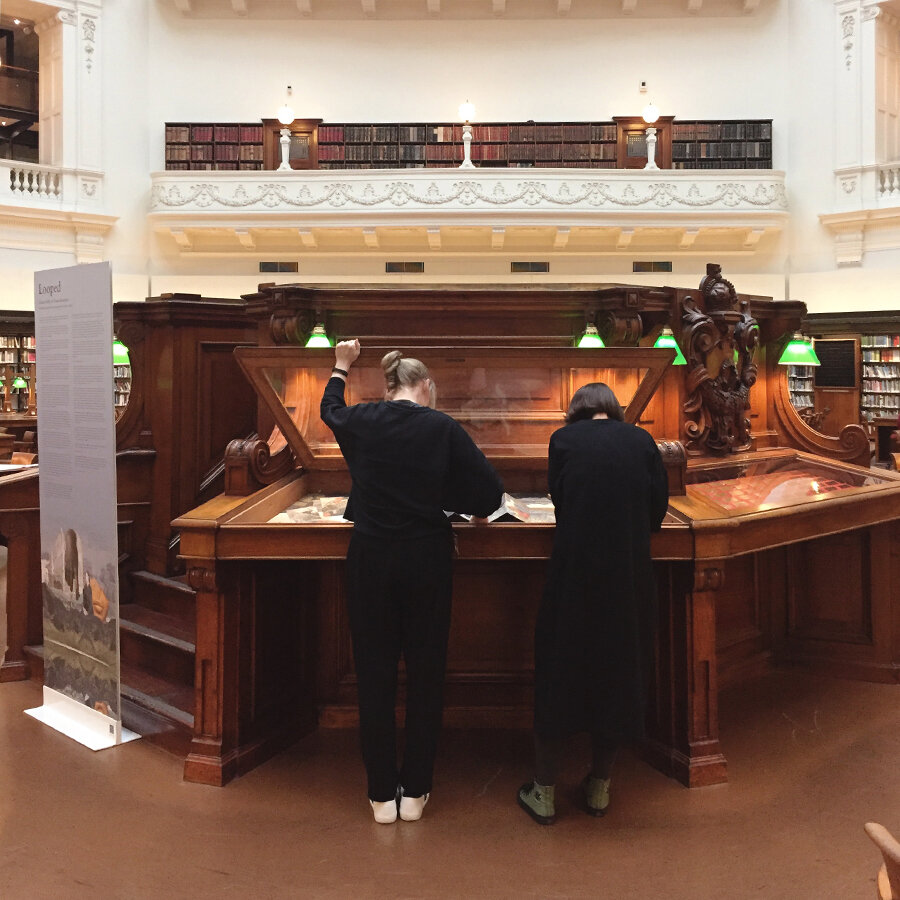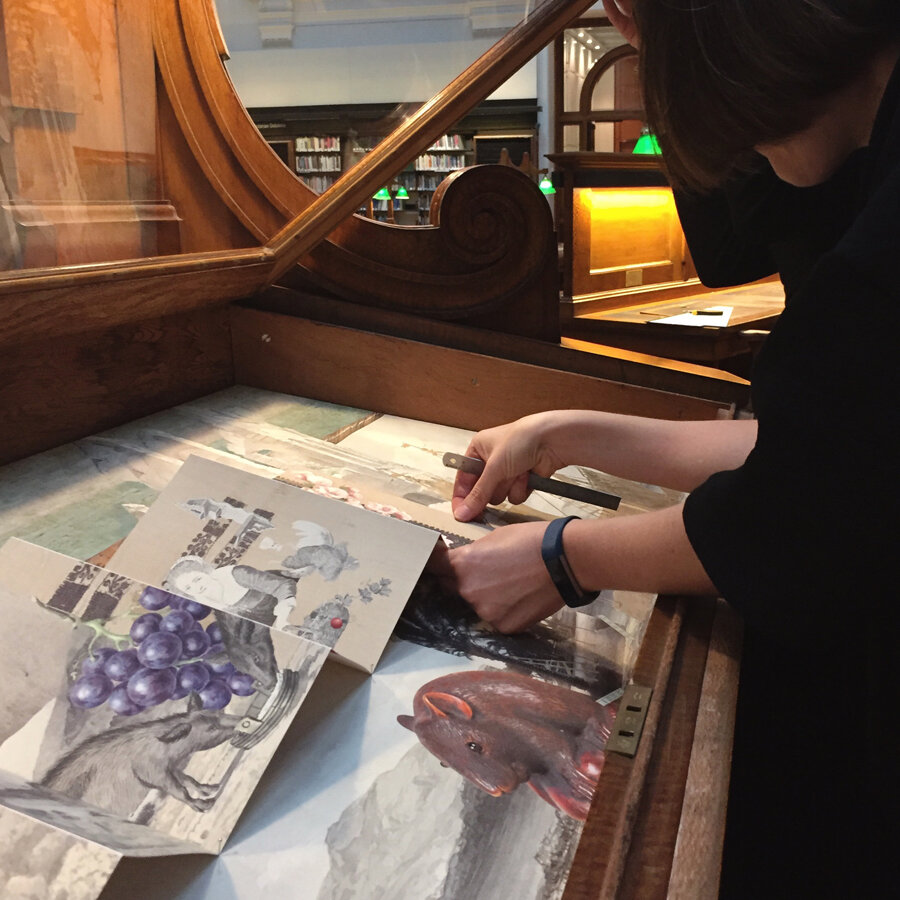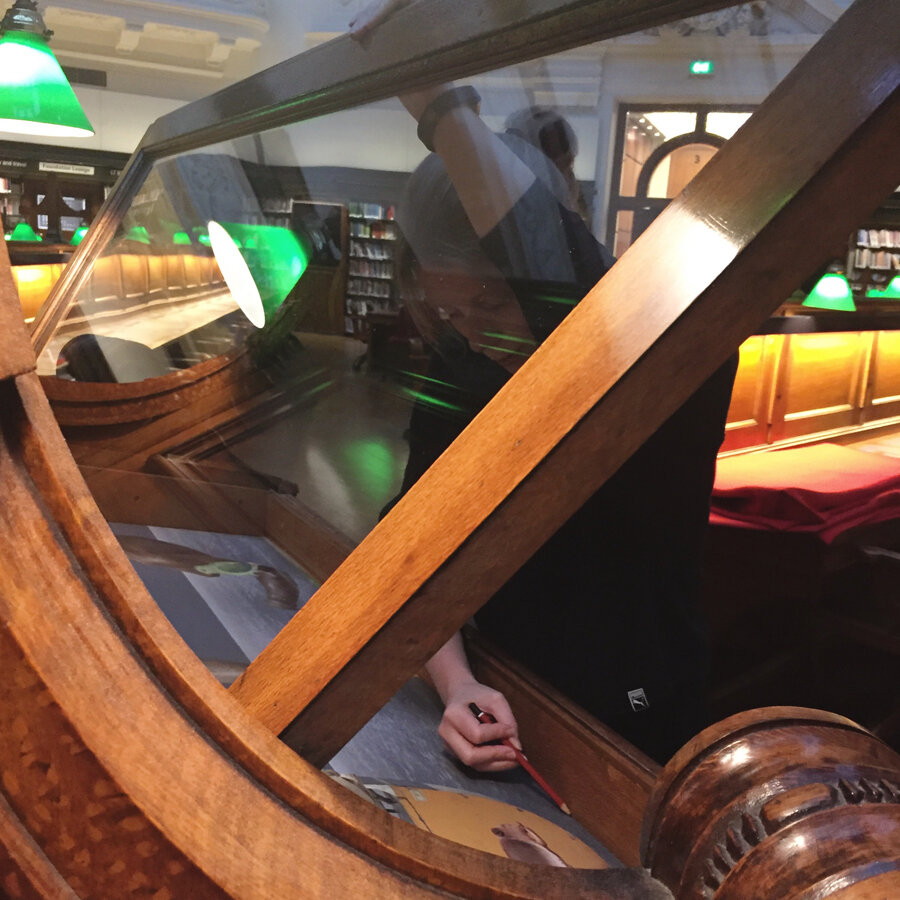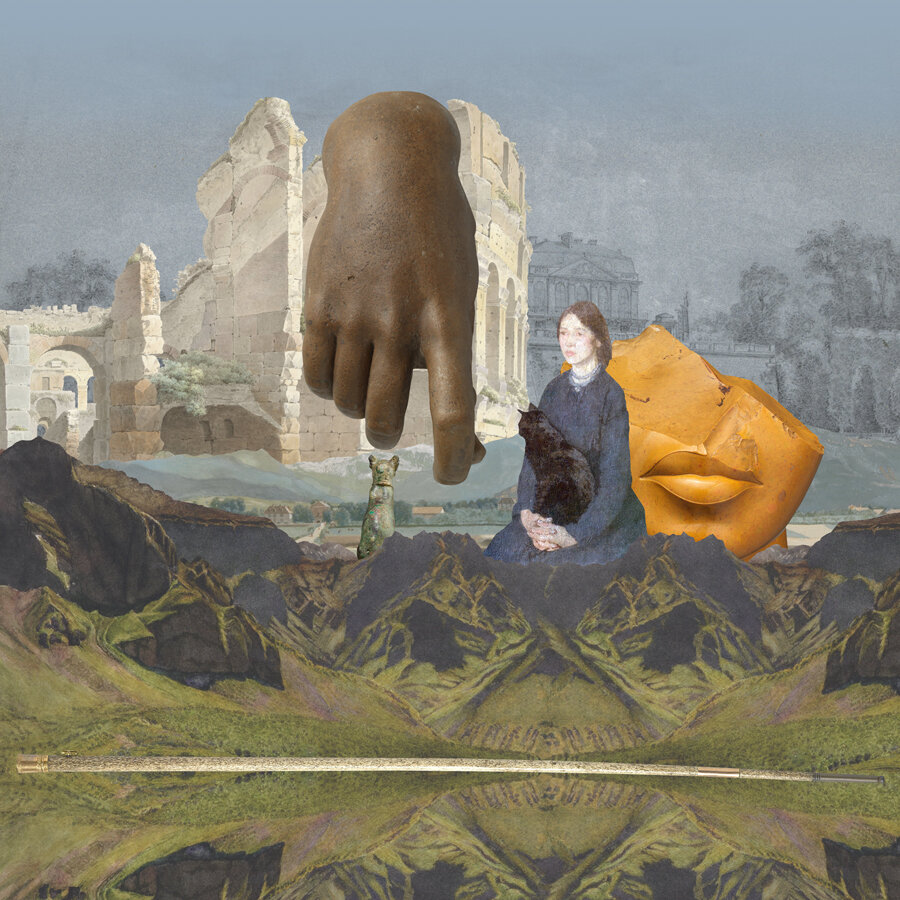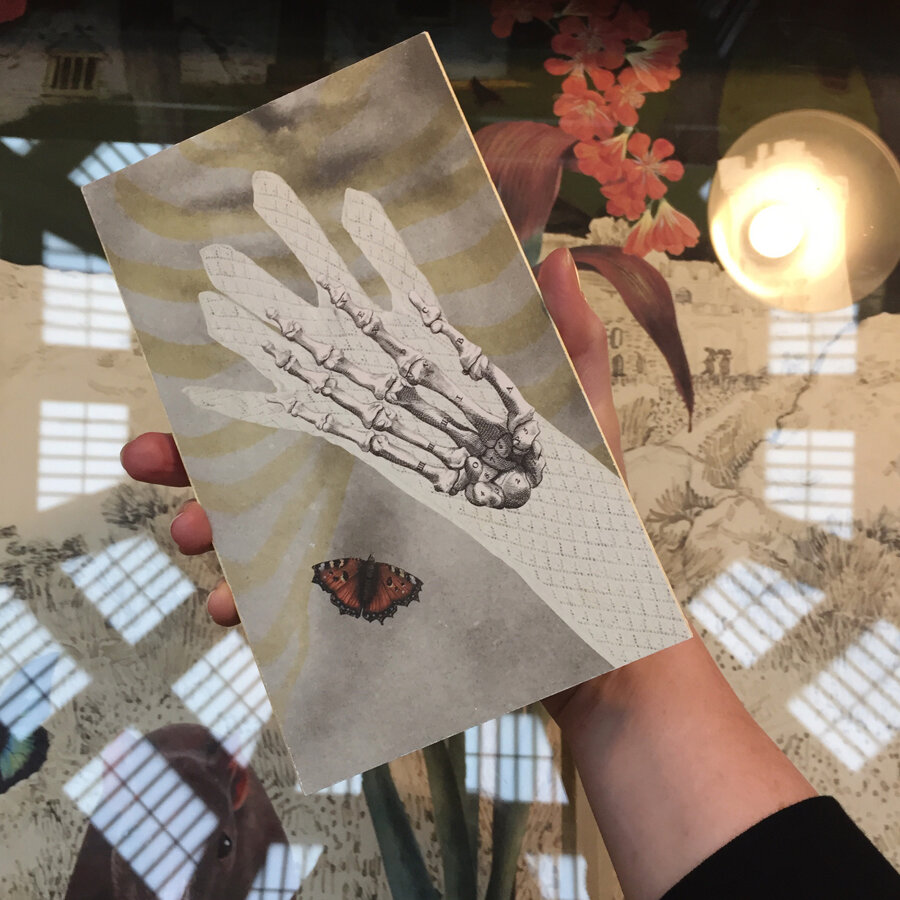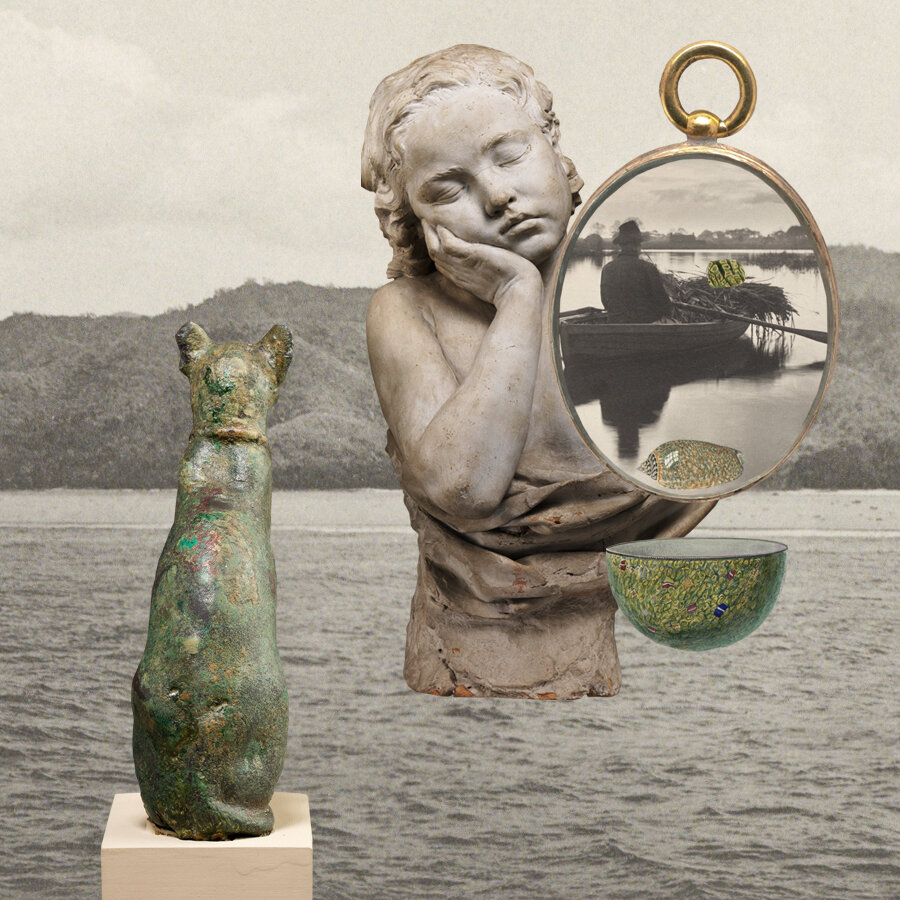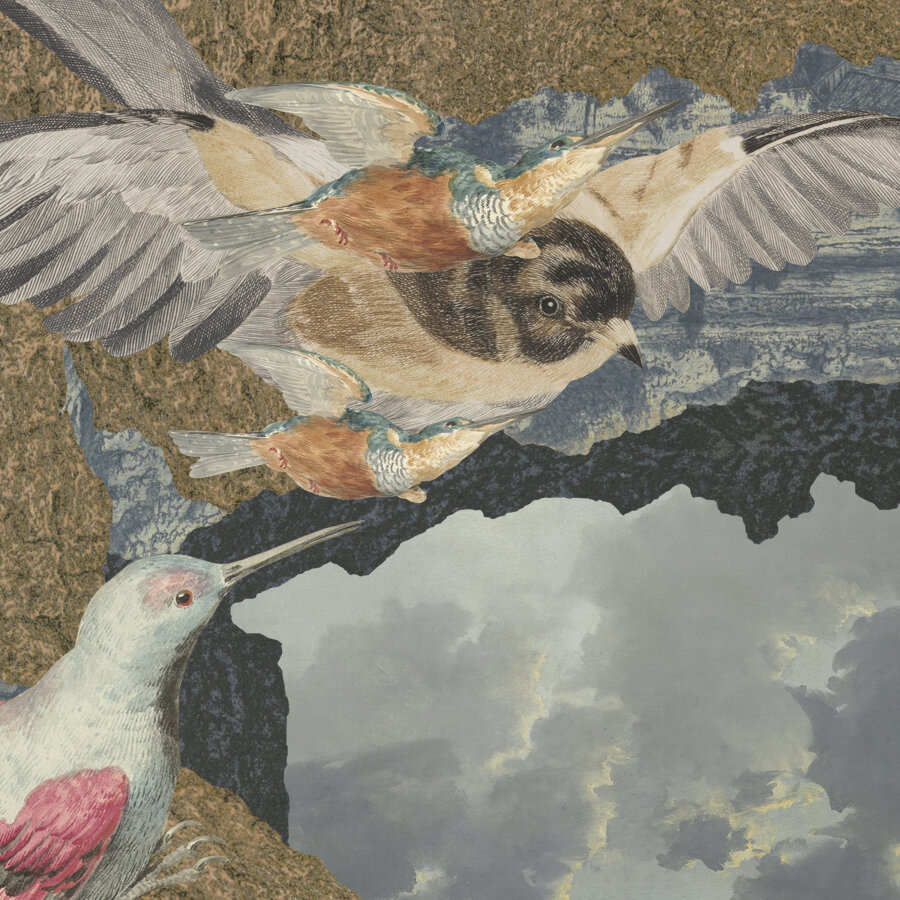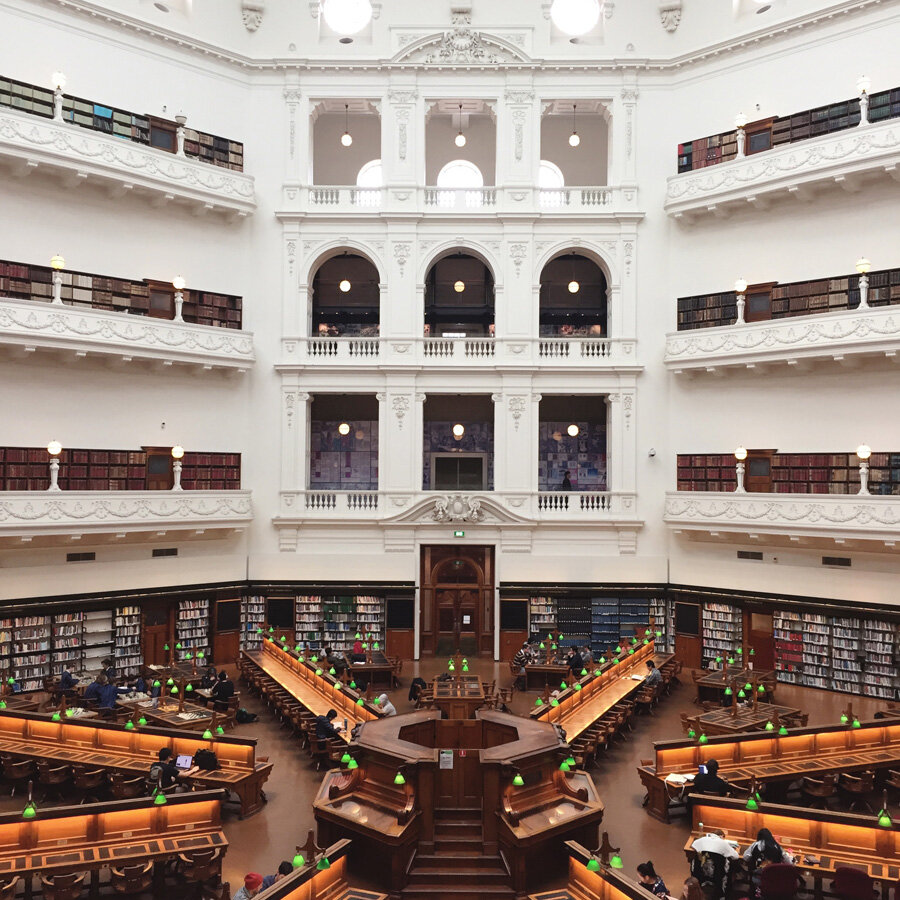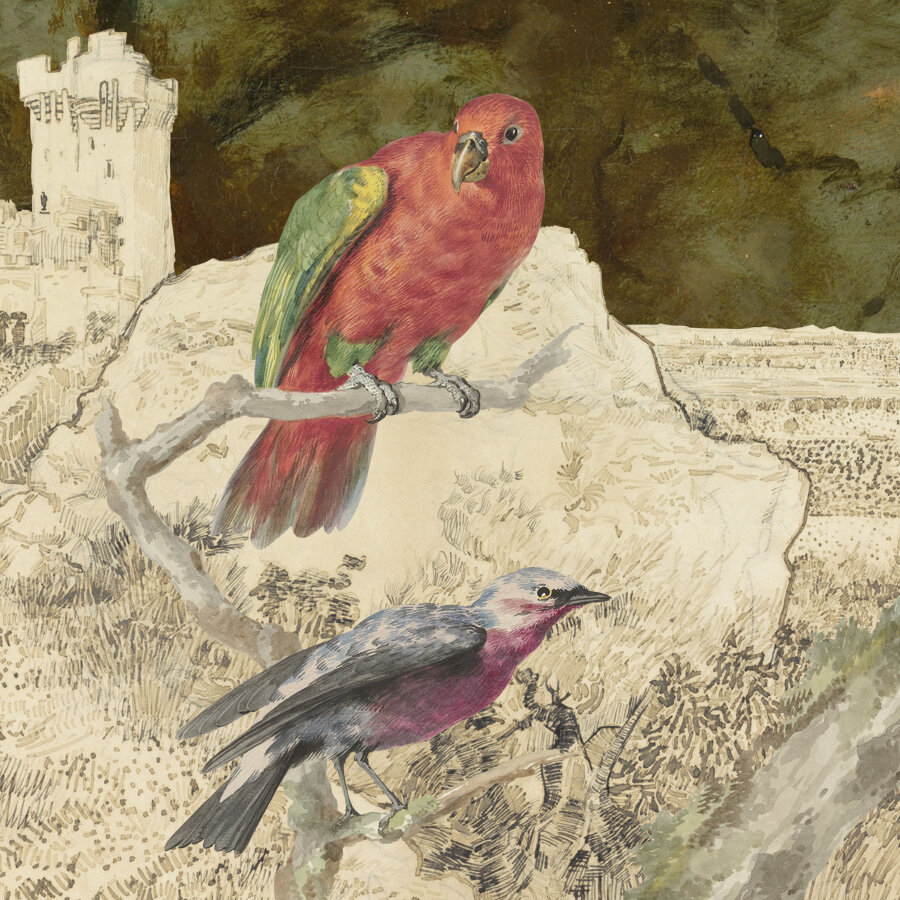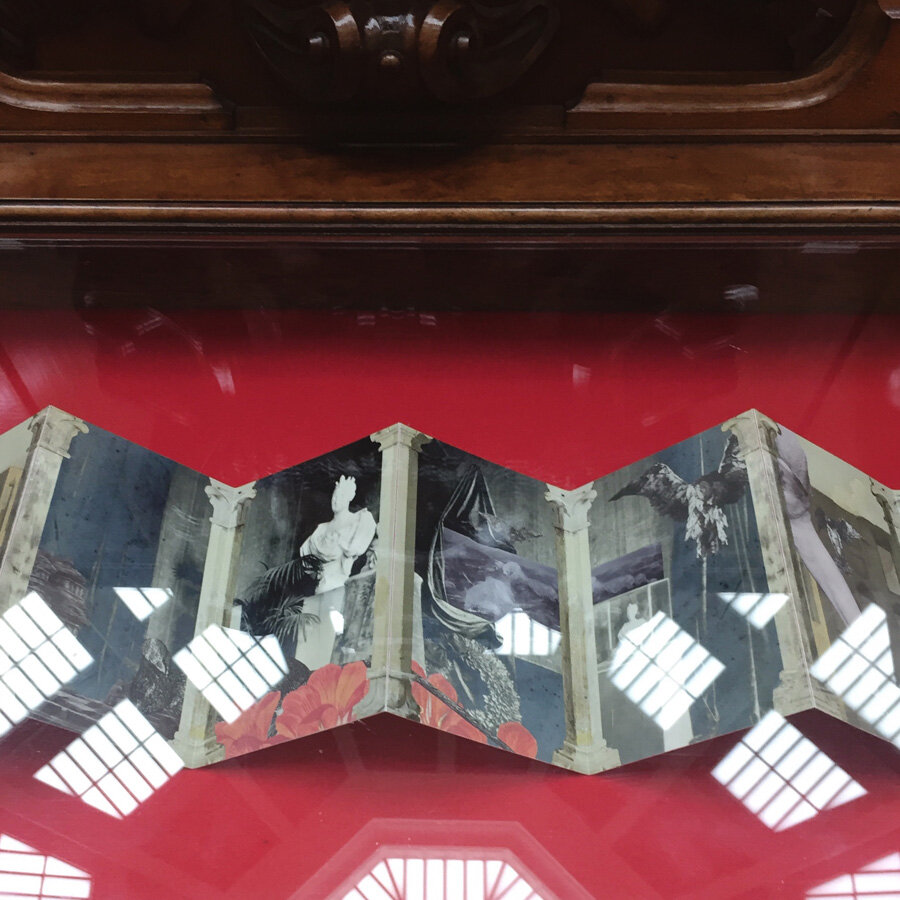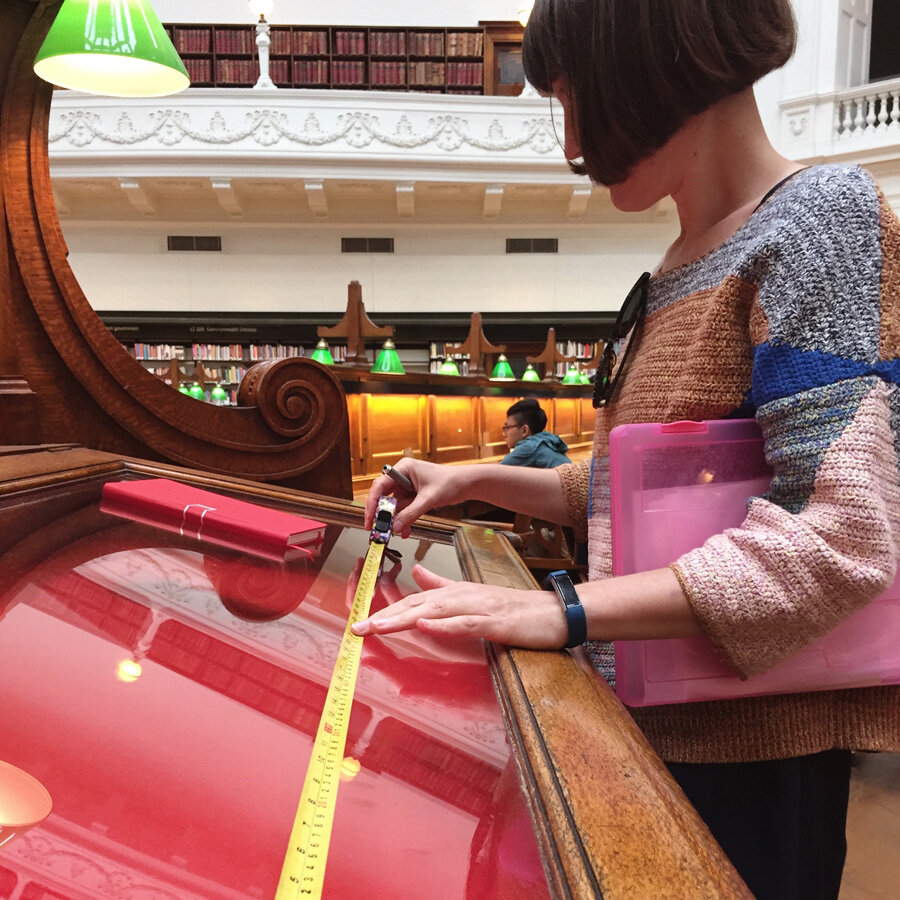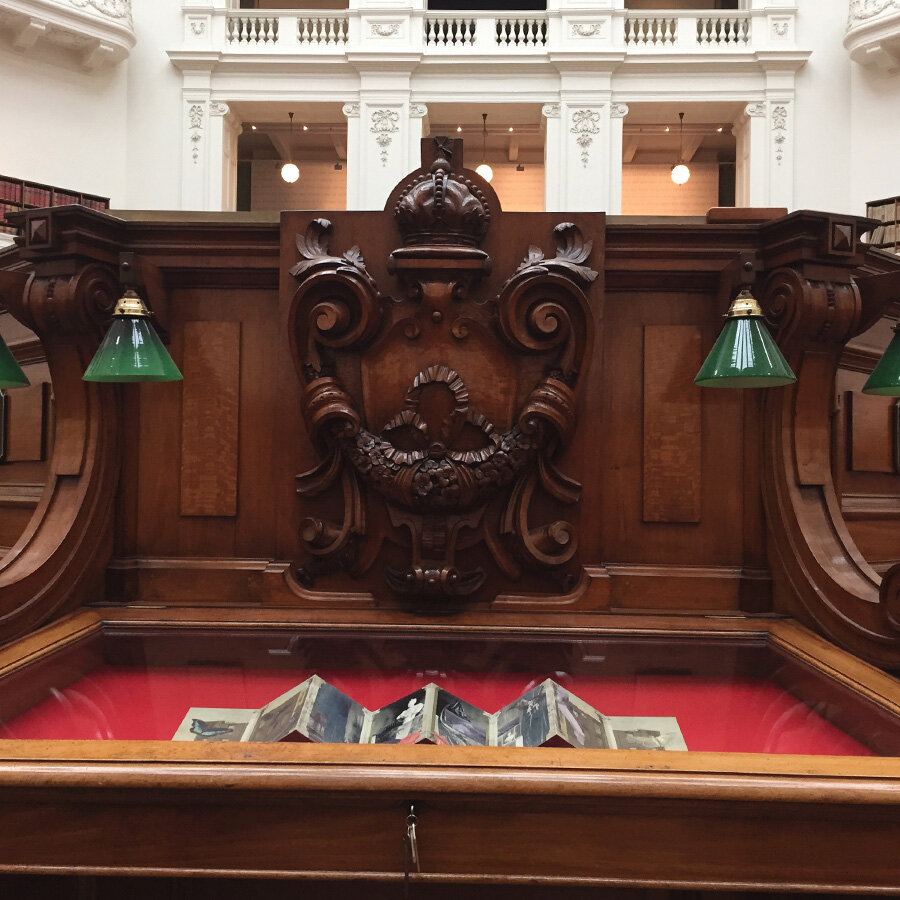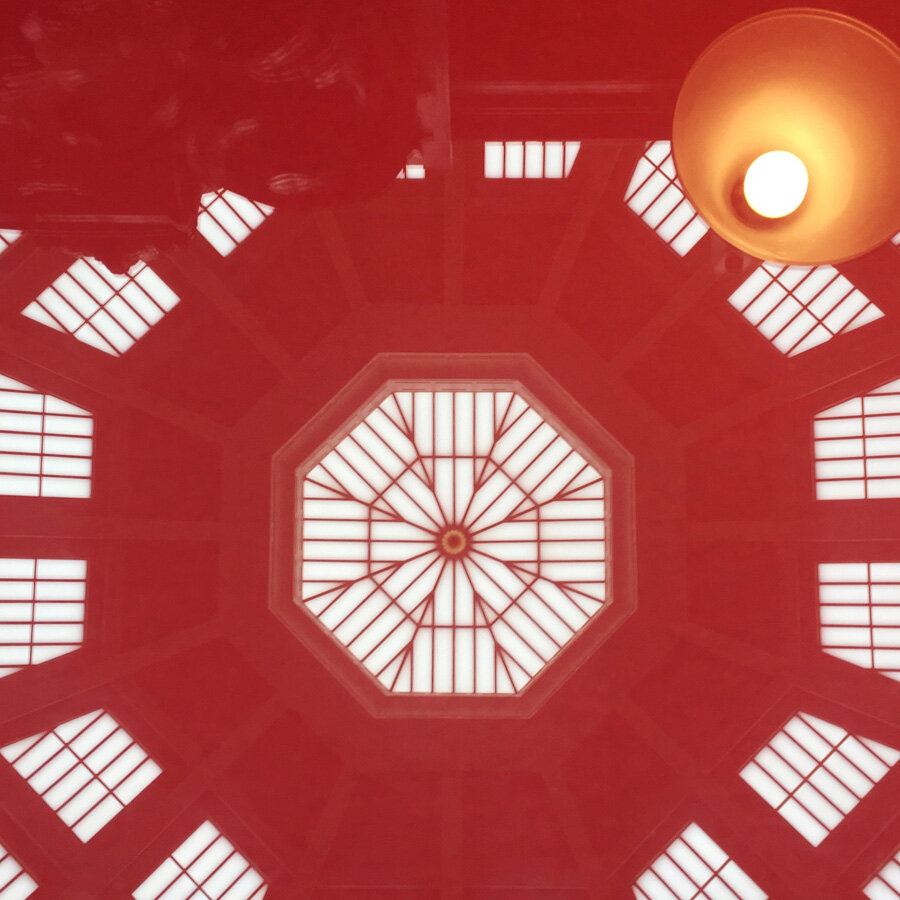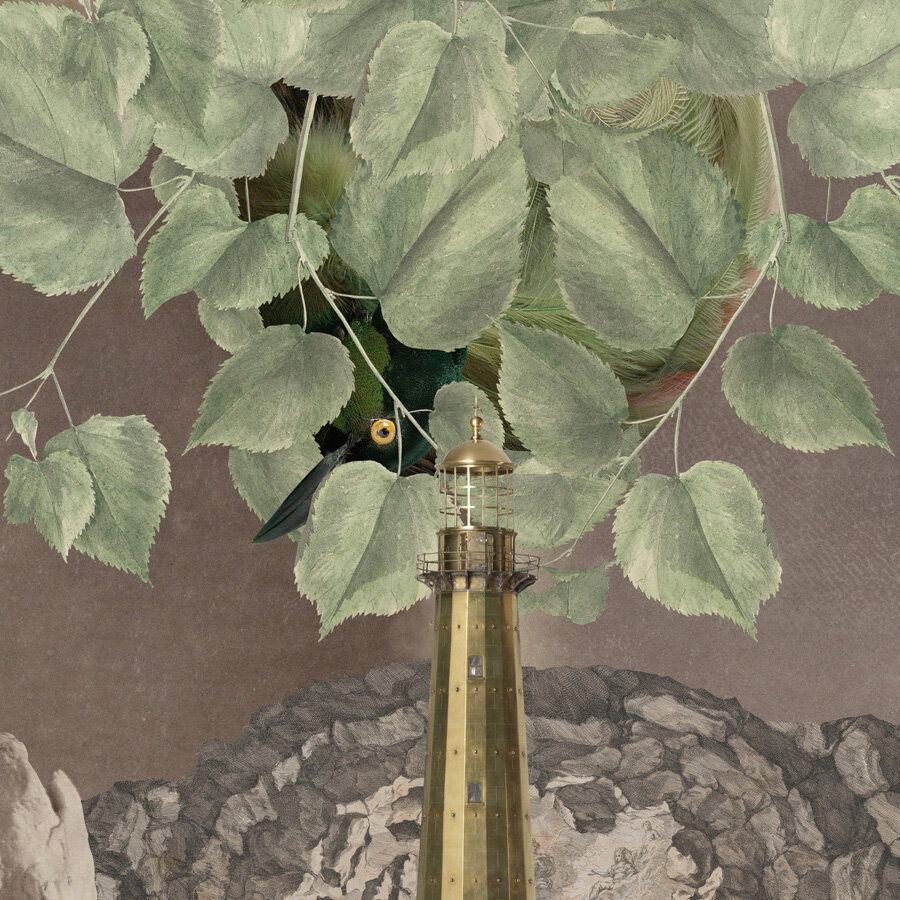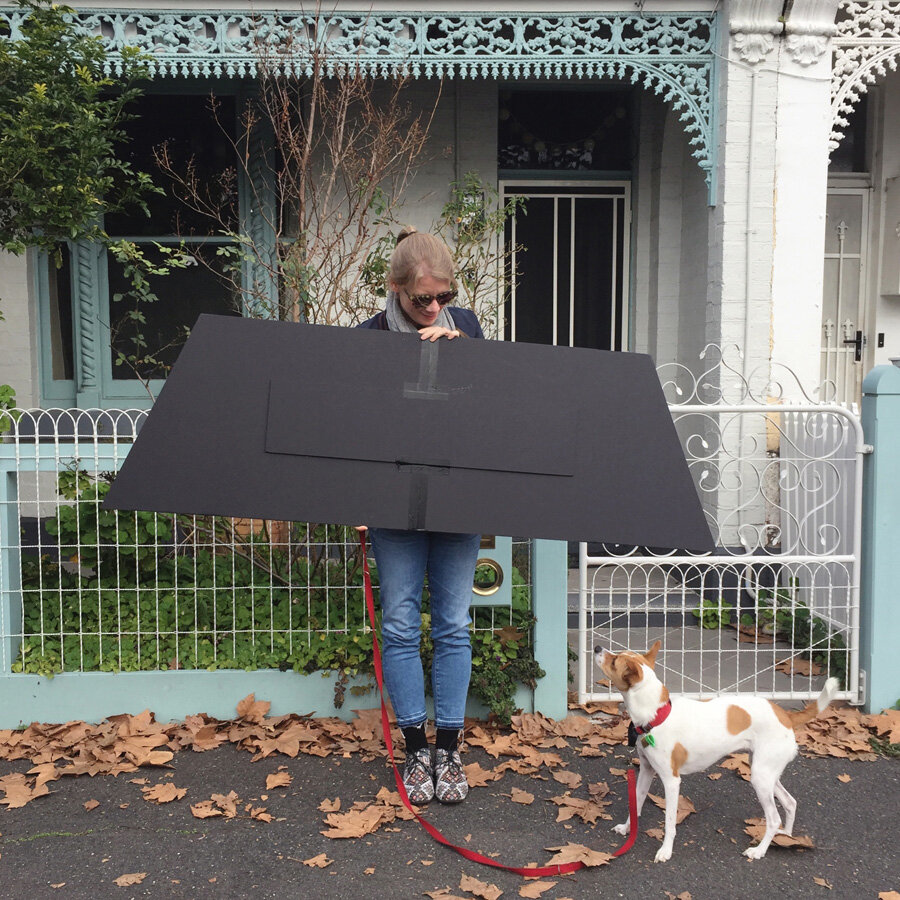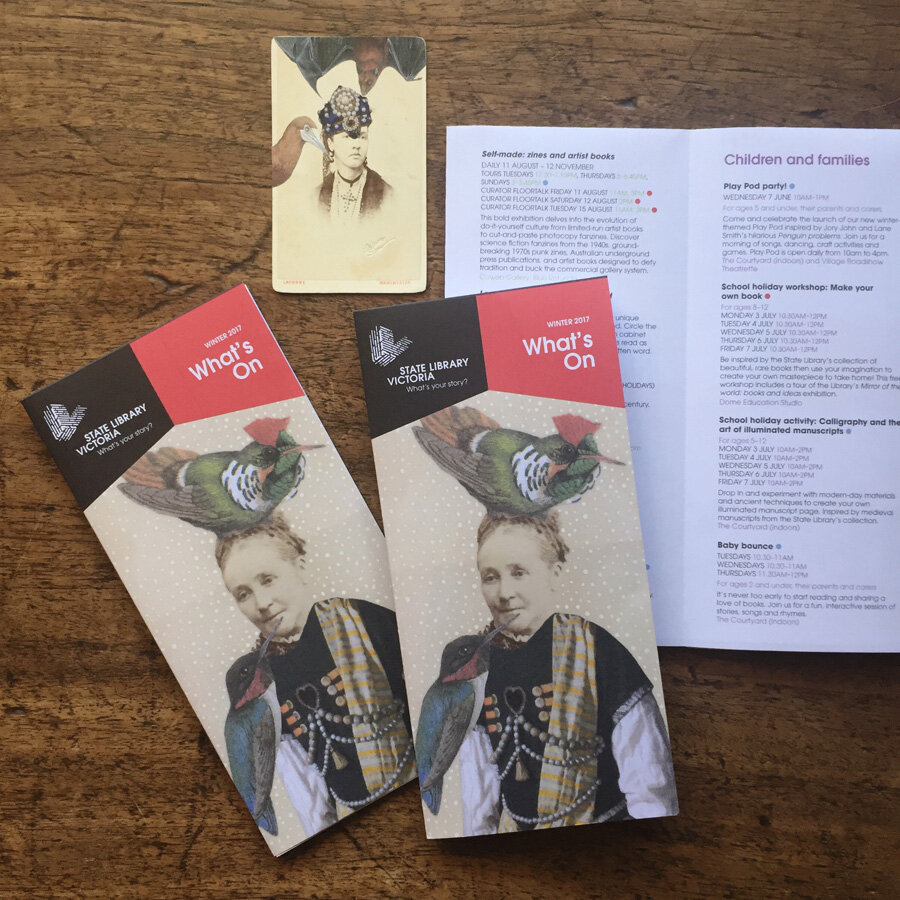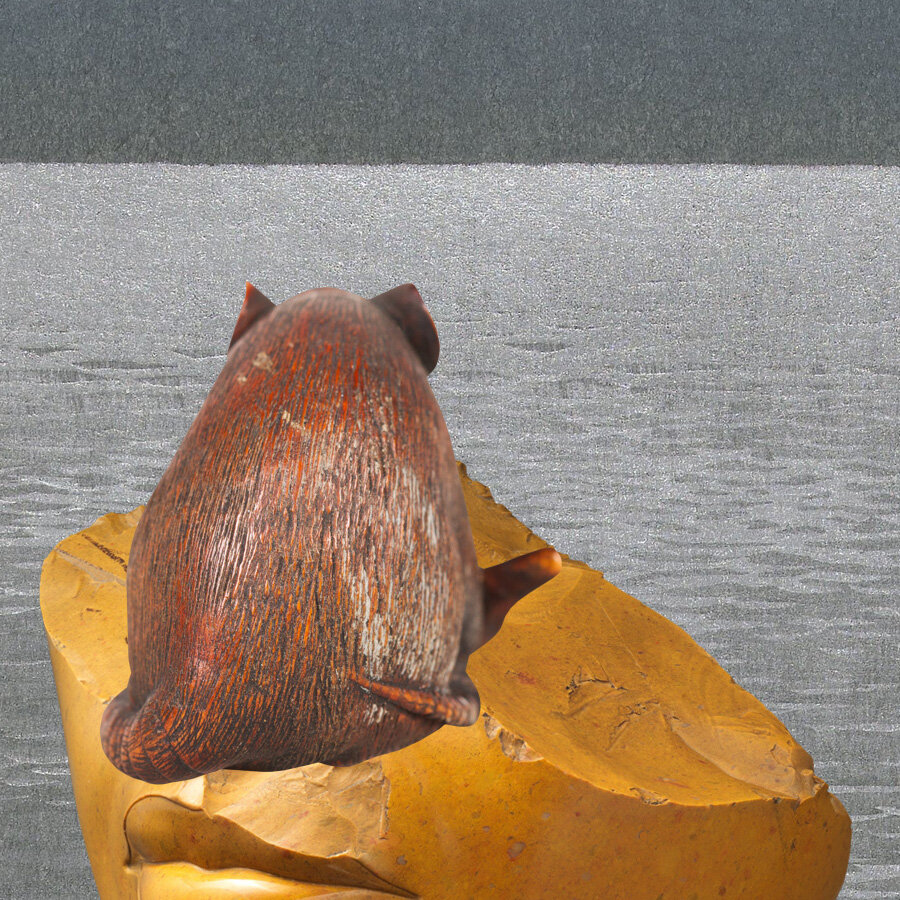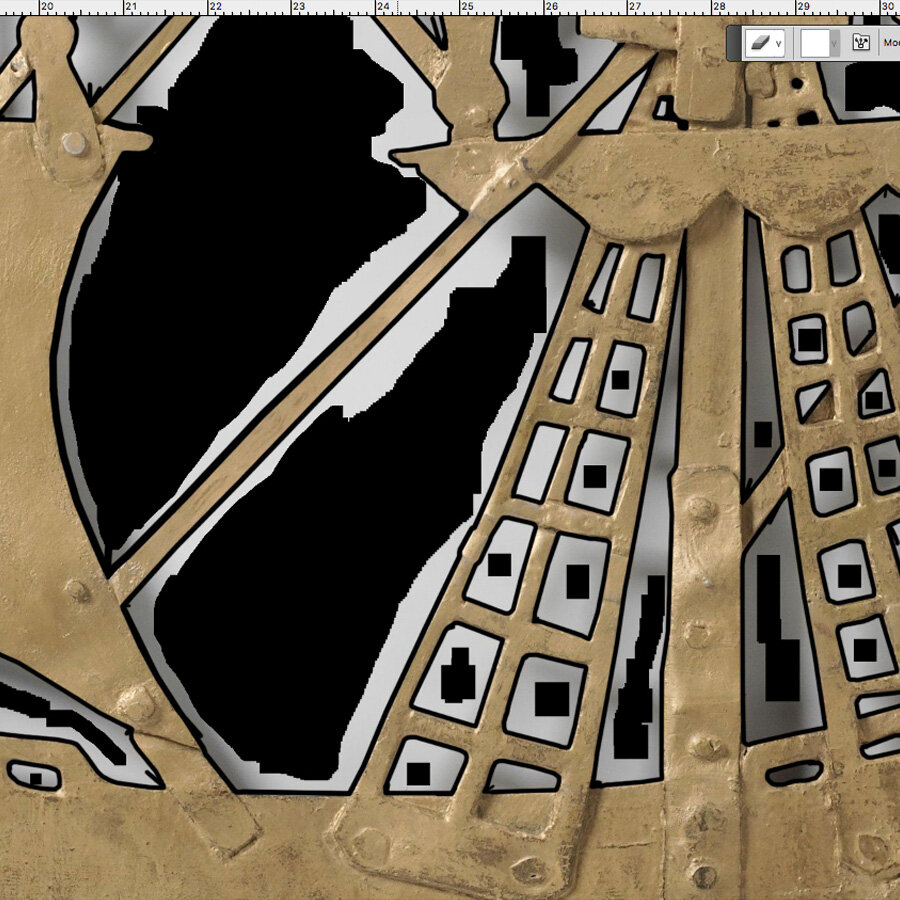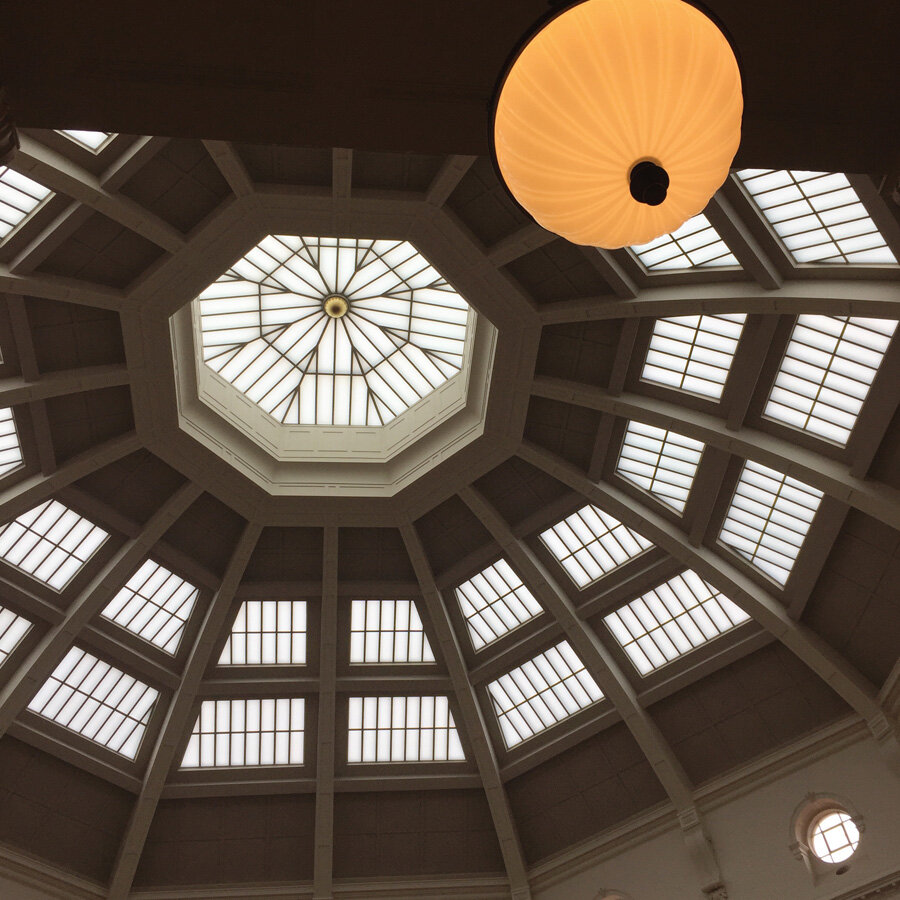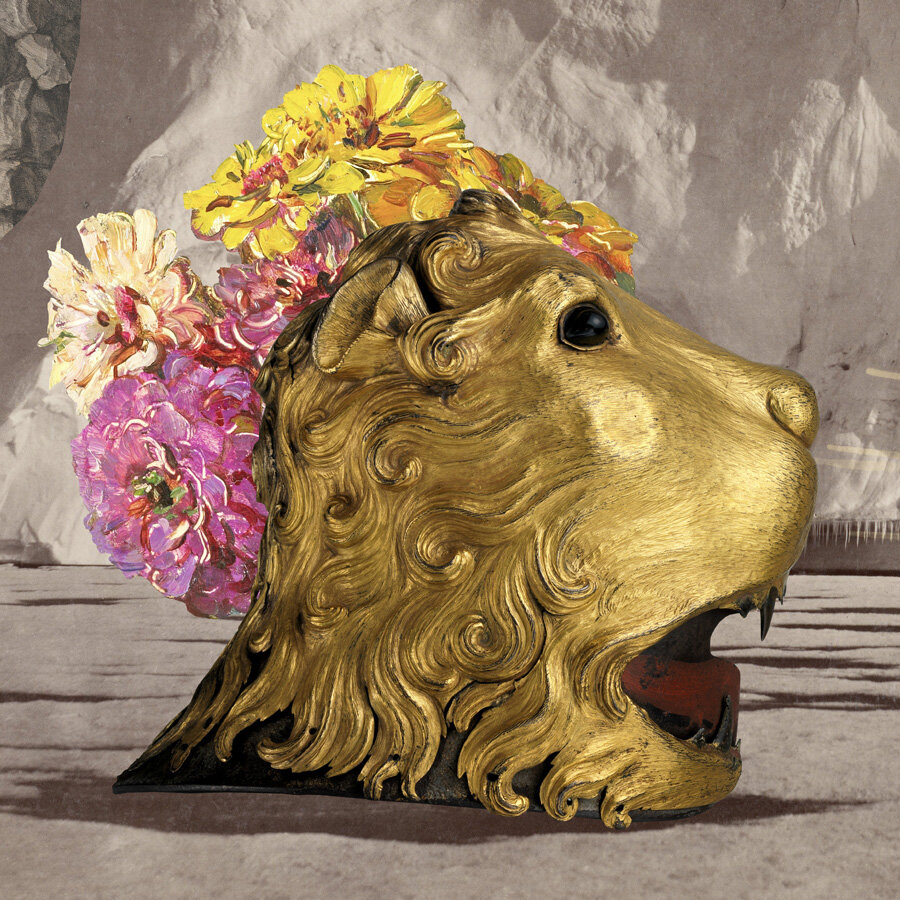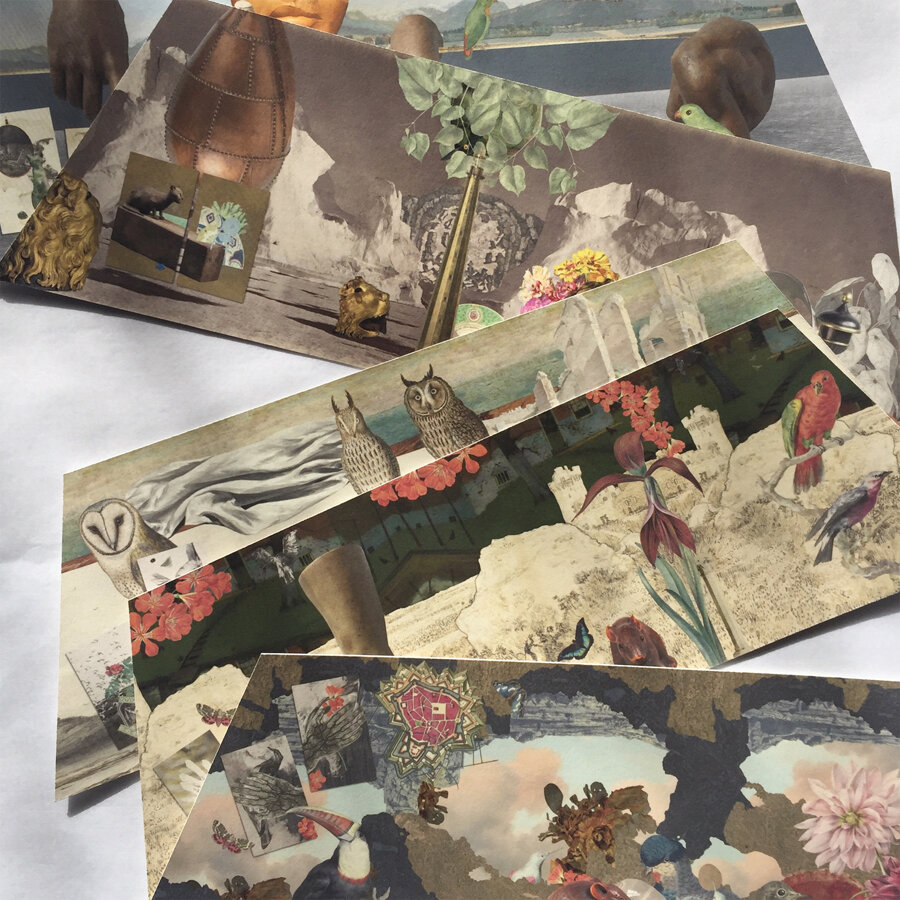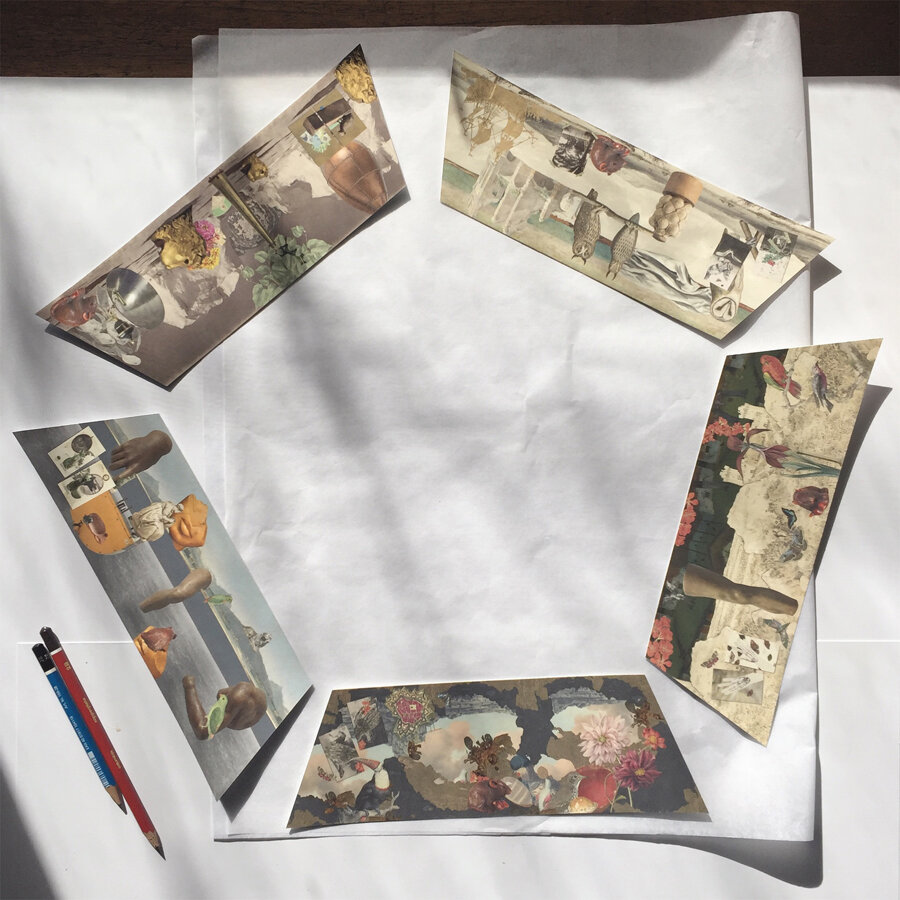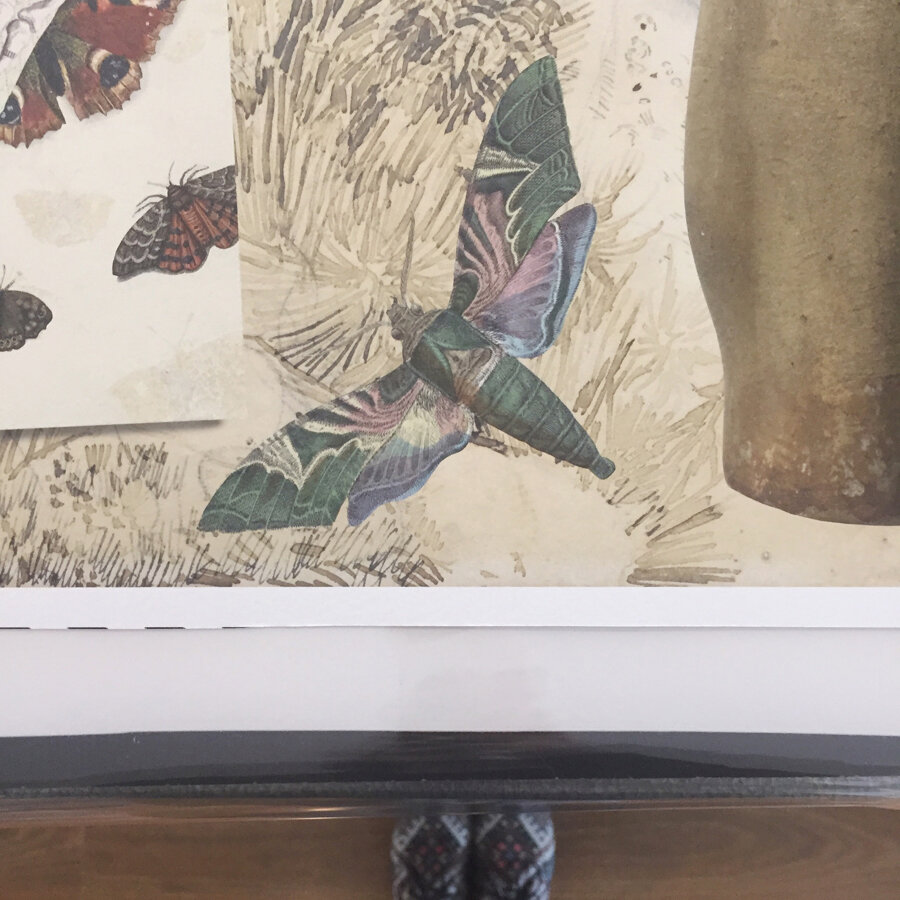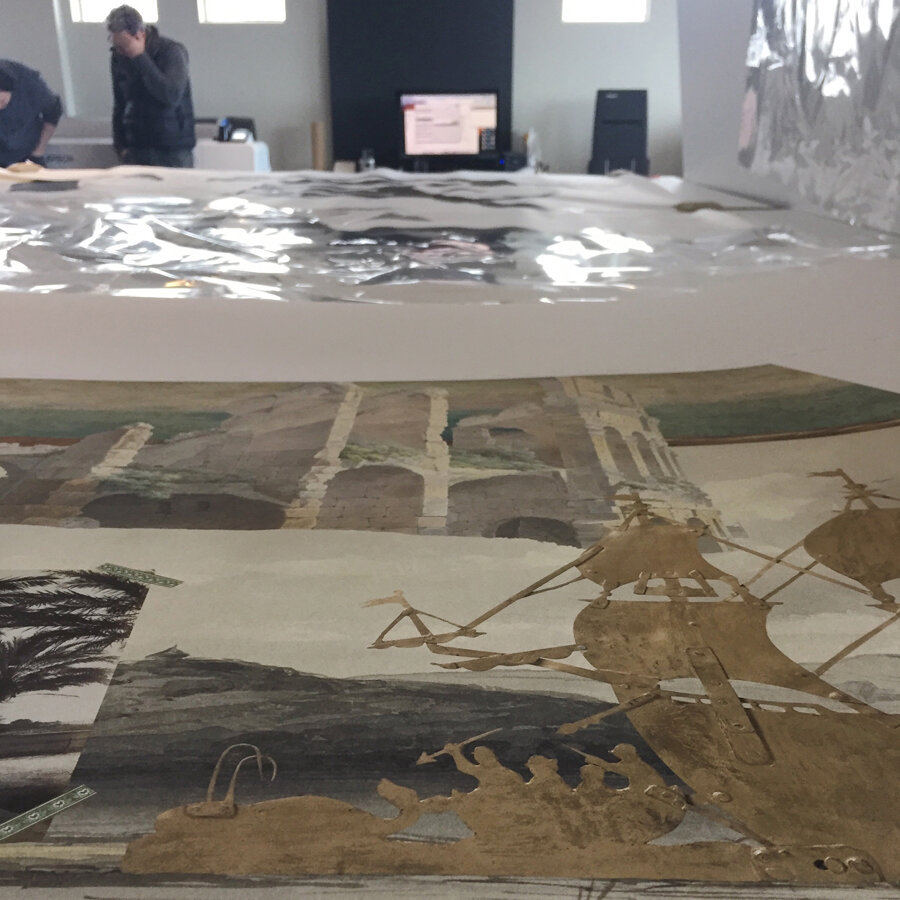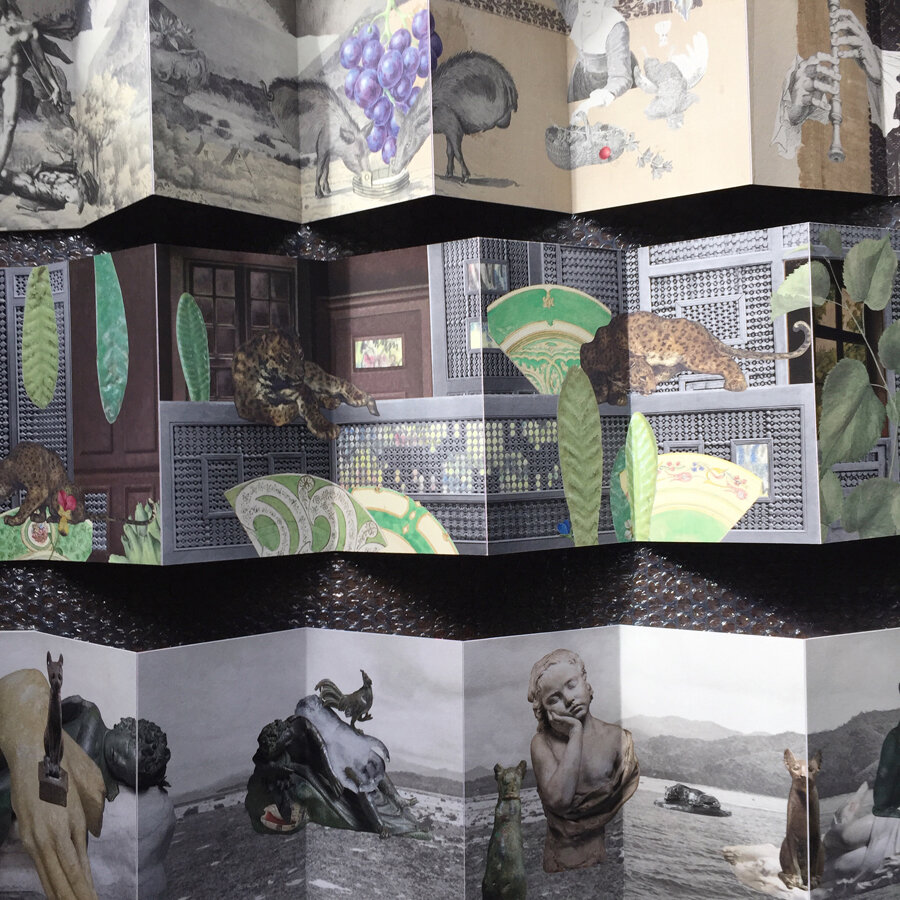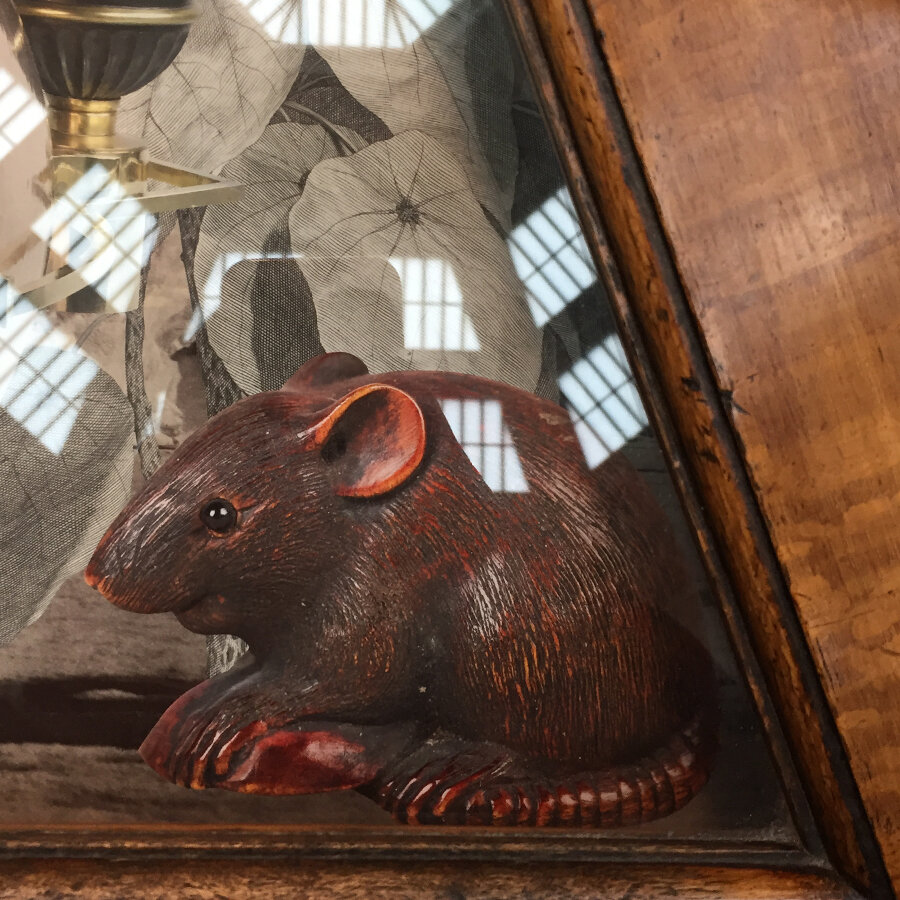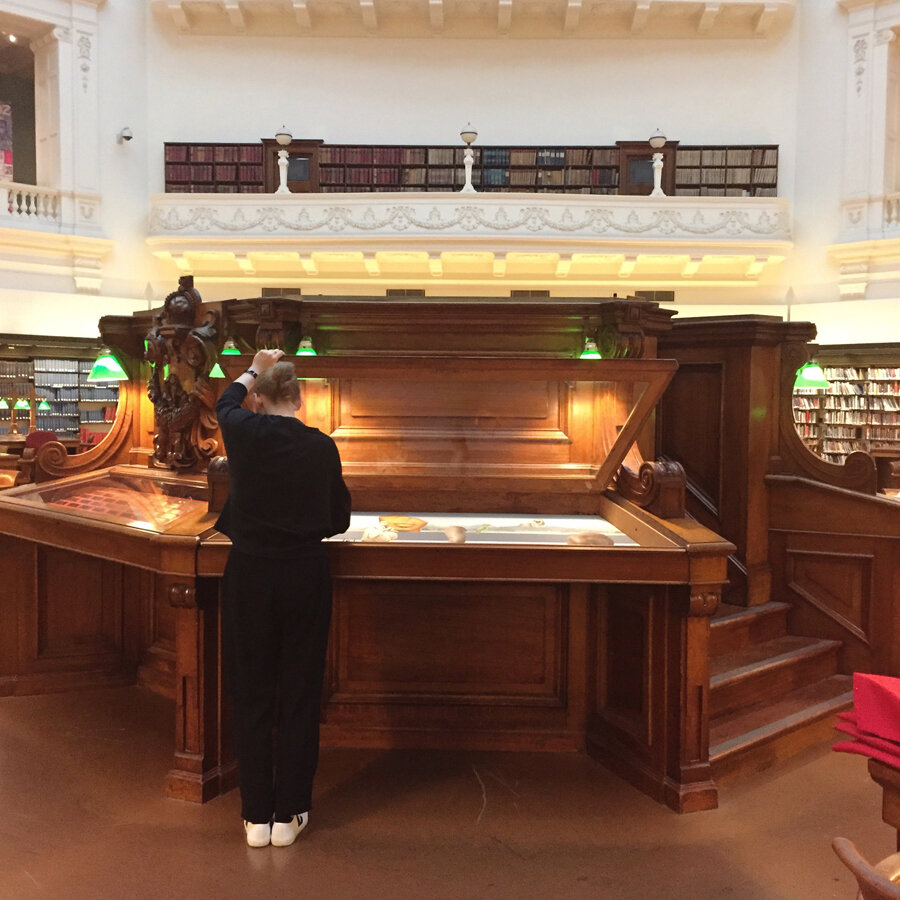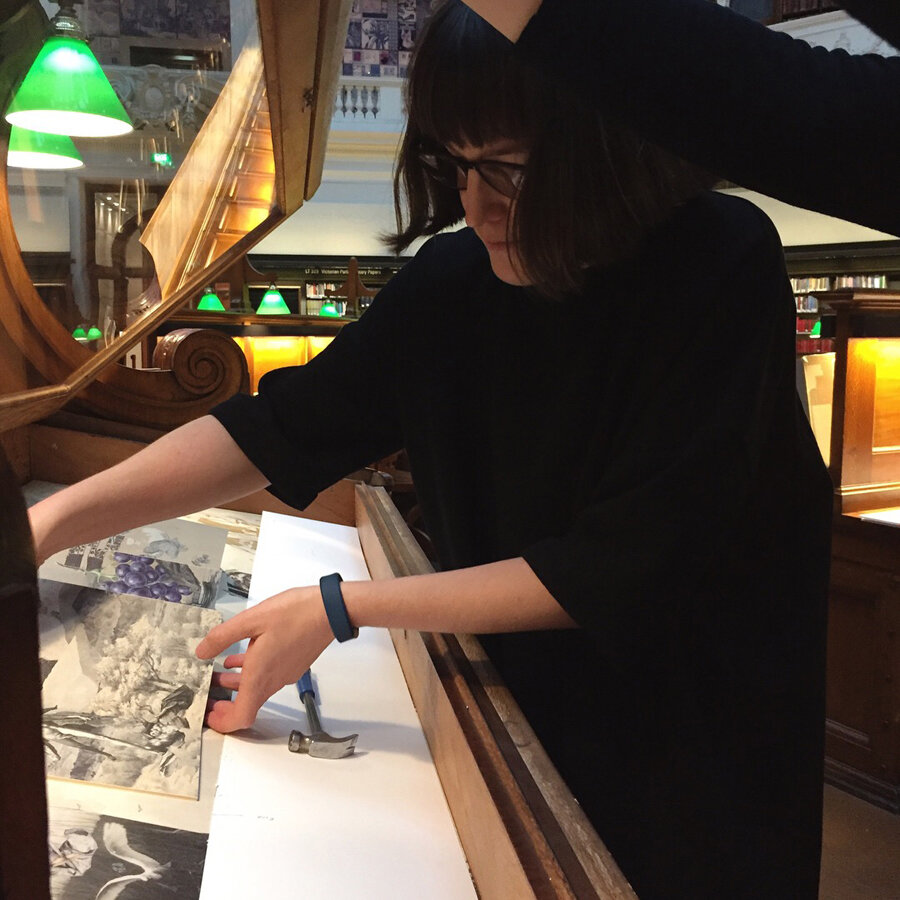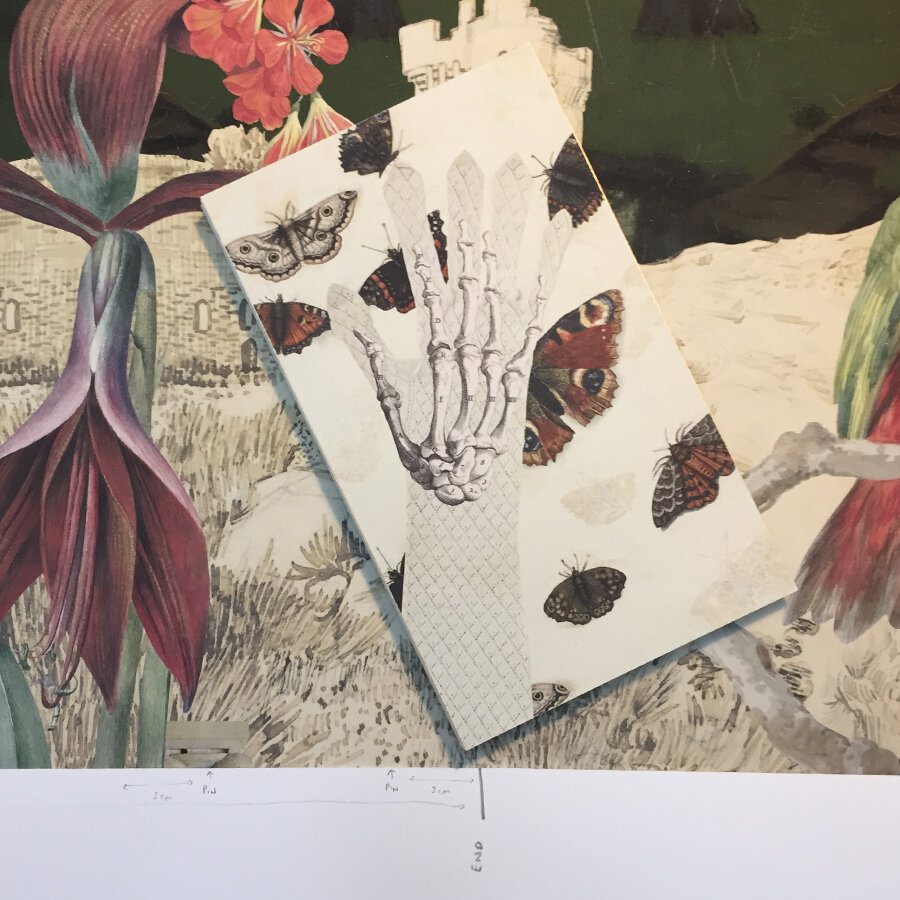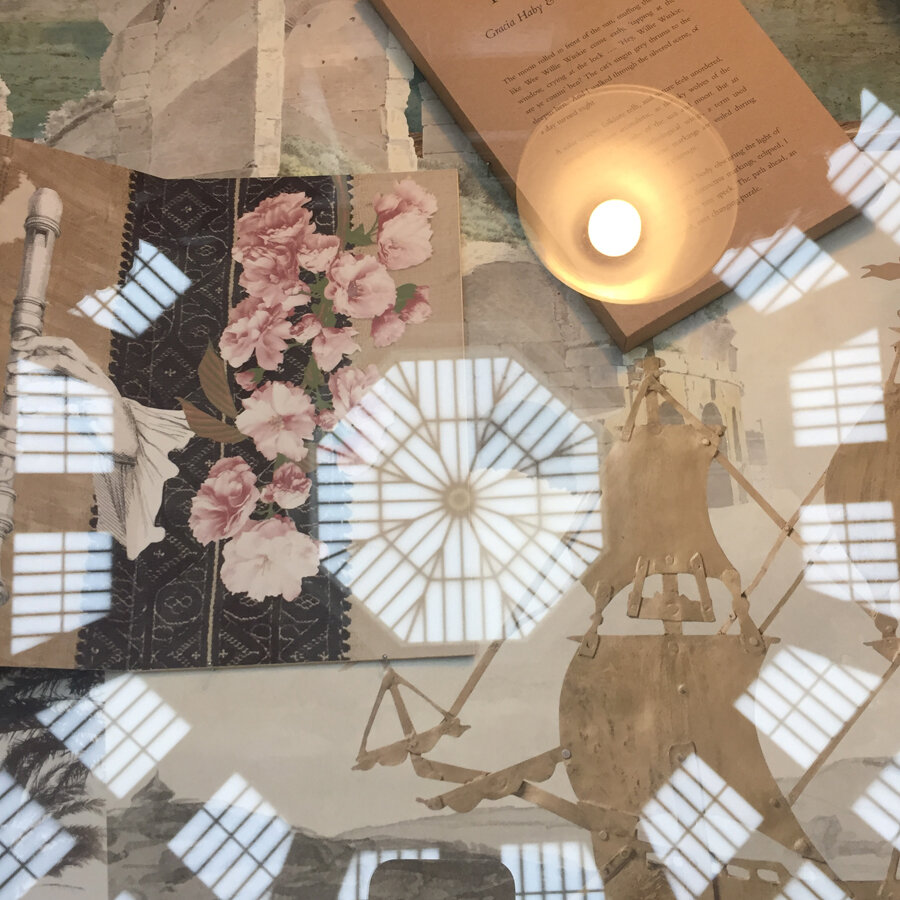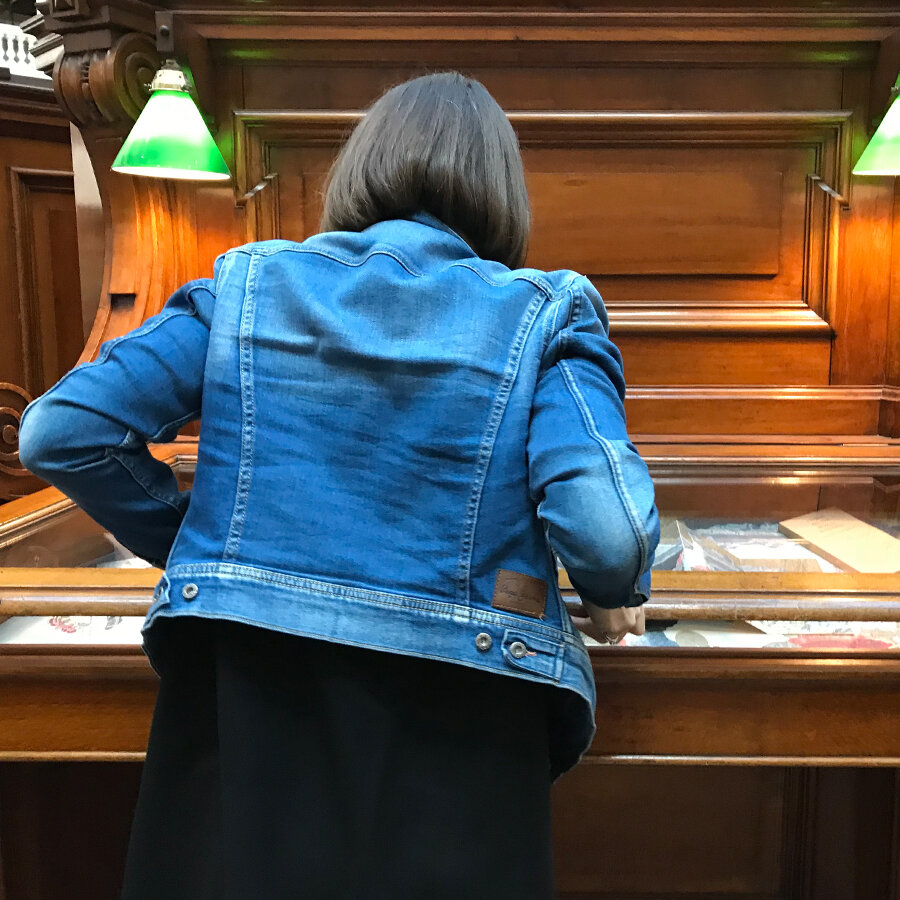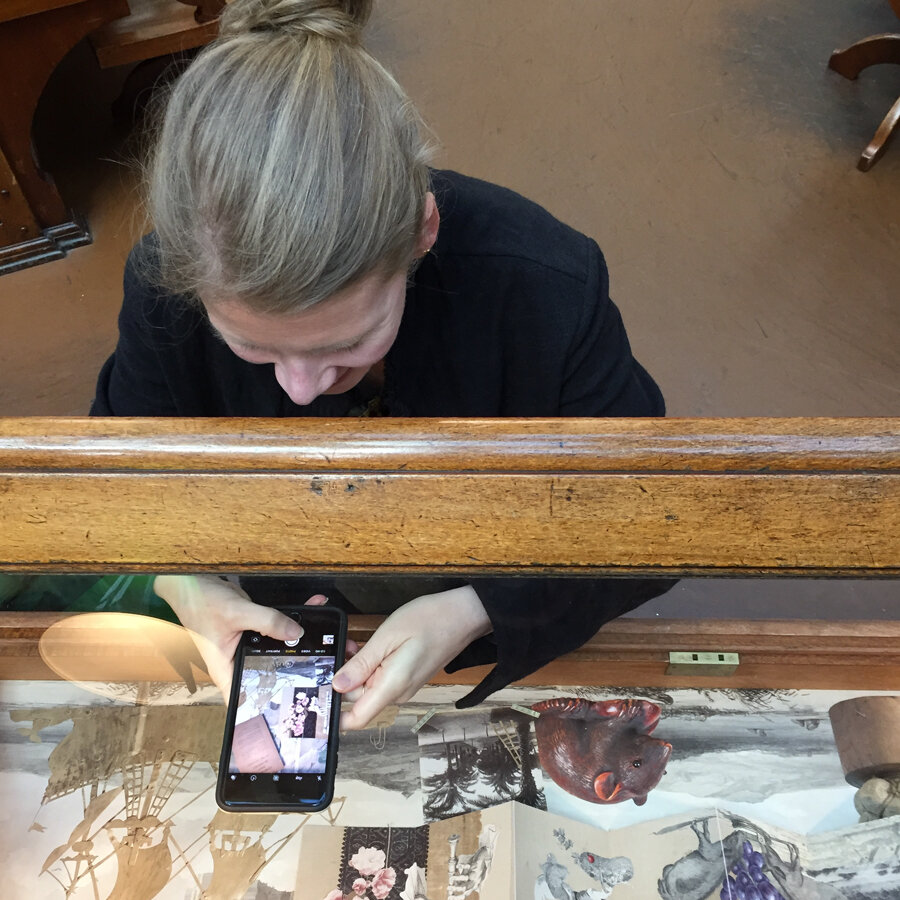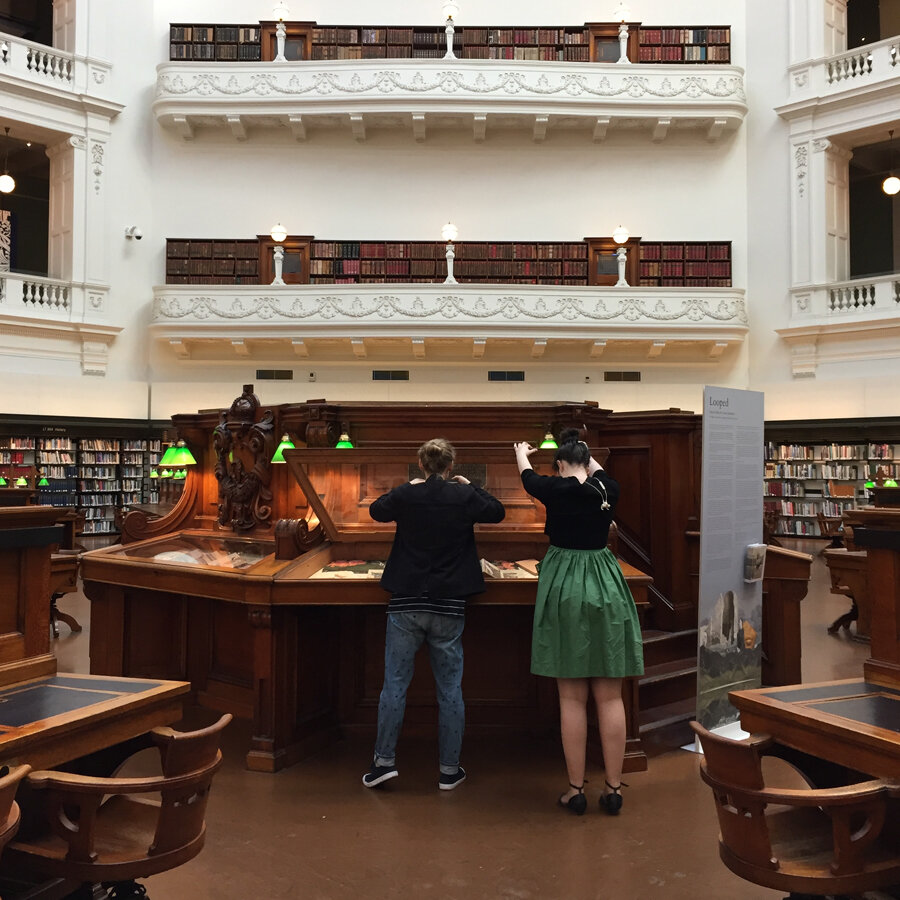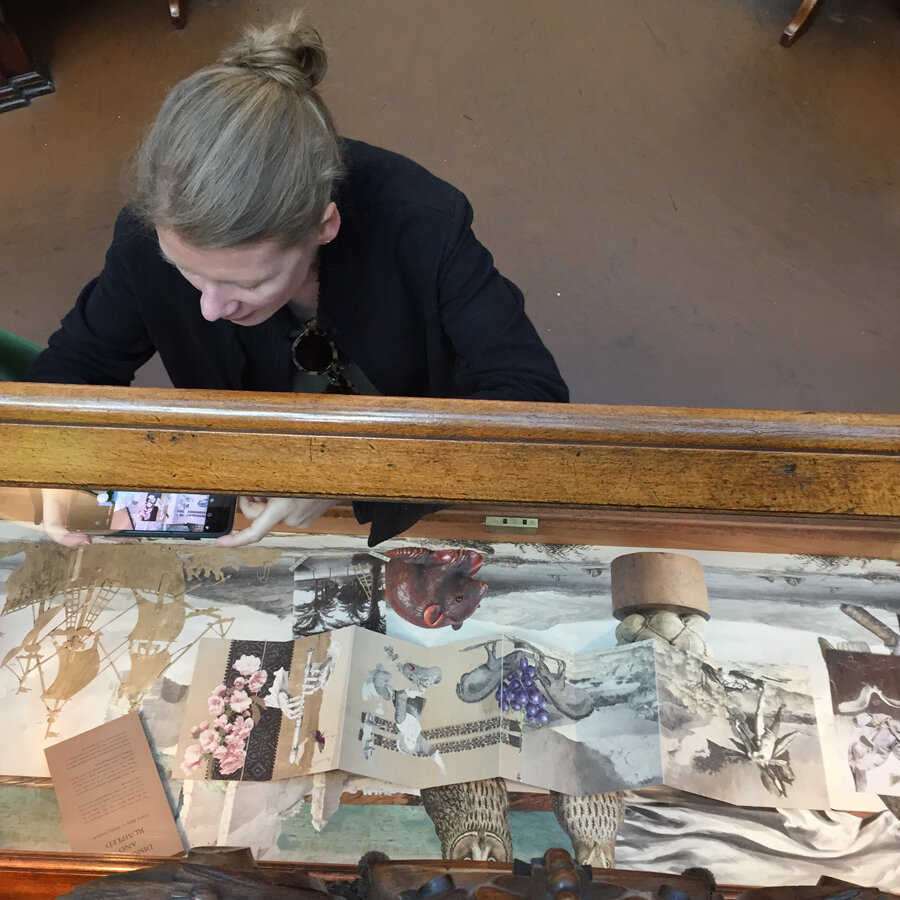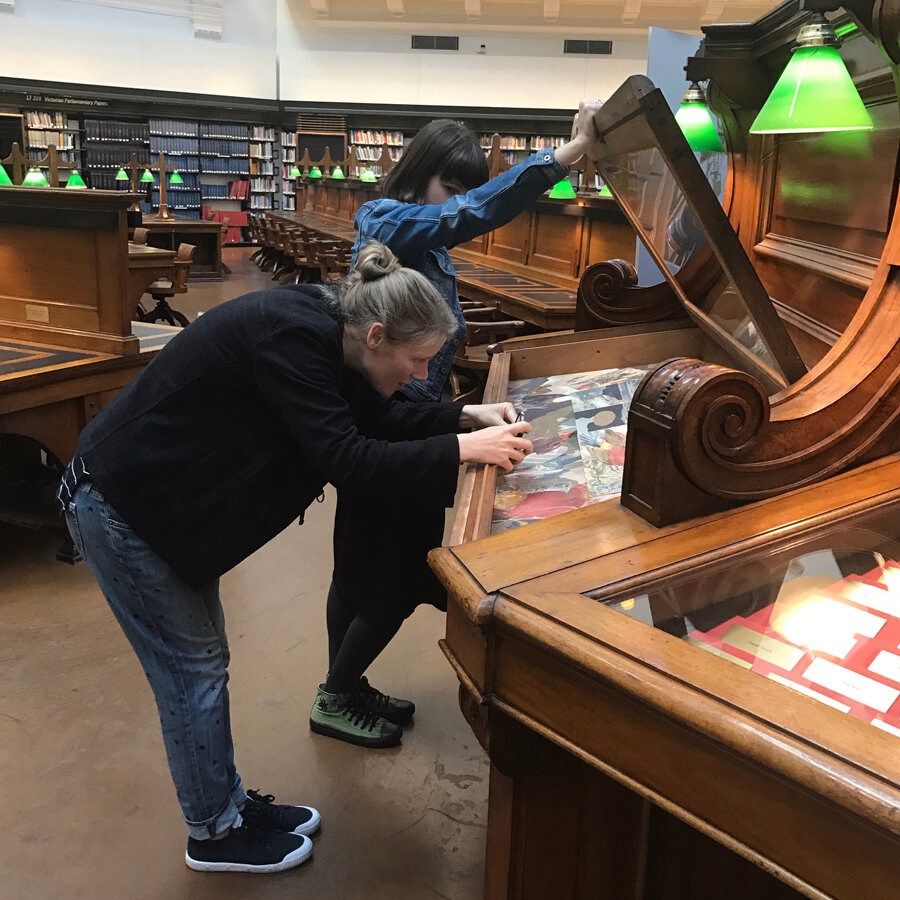LOOPED
An installation where each glass-panelled cabinet case around the domed reading room’s original heritage dais becomes a page. Together, five artists’ books read as one tale told through collage and the written word
Gracia Haby & Louise Jennison
Looped
2017–2025
Presented in partnership with State Library Victoria
La Trobe Reading Room
State Library Victoria
Friday 4th of August – Sunday 26th of November, 2017
Extended indefinitely (2025)
‘It was familiar. Yet it was out of sorts. It was a left foot crammed into the right shoe.’
We have turned State Library Victoria’s dais in the heart of the Dome Reading Room into an artists’ book. Not a book you hold in your palm, but a book that you walk around. One foot, after the other — left, right, left, right — turning the cabinet pages with your feet.
Treating each cabinet as if it were a page, our five new artists’ books extend their wings across large-scale collages. Weaving a fable beneath glass, together, they read as one. Walk and see.
●
1. I think all the world is falling
2. No longer six feet under
3. Disrupted and rumpled
4. Dim wood, spark bright
5. A warmed pebble in my hand
Gracia Haby & Louise Jennison, 2017
Five 8-page, concertina bound artists’ books. Inkjet print on Hahnemühle Photo Rag 308gsm, with covers mounted on gold-trimmed board, housed in a printed slipcase on 225gsm Buffalo board. Printed by Arten (covers, pages) and Bambra Press (slipcases). Each an edition of 6, with an artists’ proof.
Five trapezoid collages. Inkjet print on Hahnemühle Photo Rag 308gsm. Printed by Arten.
You can see Looped as it sits in the library now and how it all came together nestled beneath #GraciaLouiseLooped.
Throughout 2017, you could collect a free 16-page zine, which included the text, A whisker lighter, and list of works from a stand at the dome dais. This zine is now available through our online store.
2021: Looped had its dates extended indefinitely and can still be experienced in the dome
Our stationary cats and a netsuke mouse have been minding their Ps and Qs since August, 2017, and we are delighted that our Looped inhabitants, like those within A warmed pebble in my hand, are staying in the dome dais indefinitely.
Thank-you, State Library Victoria.
Looped was originally a satellite exhibition to Self-made: zines and artist books, of which our work was also a part of, a travelling State Library exhibition which began in the Blue Rotunda, Cowen Gallery, State Library Victoria in 2017, and toured regionally until 2020.
﹏
RELATED LINKS,
#GRACIALOUISELOOPED
#THEWORKINGTABLE
LOOPED IN THE DOME (STATE LIBRARY VICTORIA)
LOOPED (STATE LIBRARY VICTORIA)
REEL 2020–2025
RELATED POSTS,
”SAYING THINGS, IN WORDS BEFORE WORDS”
Q & A
A WARMED PEBBLE IN MY HAND; A ZINE IN YOURS
SUNDAY, STICKILY
STAYING PUT
LA TROBE READING ROOM
A WHISKER OF LIGHT
LOOPED IN THE LIBRARY
"AN AFFAIR OF VOLUMES"
TRAPEZOIDAL
LOOPED
FINITO
SET, READY, SCISSORS
FAIRGROUND BECKONS
ON THE WORKING TABLE
The Blue Notebook: Journal for artists’ books
Inside Volume 12, No. 2 Spring – Summer 2018 (pp. 6–14) of The Blue Notebook: Journal for artists’ books, published by Wild Conversations Press, edited by Sarah Bodman, UWE, Bristol, UK, you’ll find us talking about our artists’ books within Looped, at State Library Victoria.
The Blue Notebook
Head to Book Arts to subscribe (hard copy and digital).
Looped
Gracia Haby & Louise Jennison
An installation by Gracia Haby and Louise Jennison where each glass-panelled cabinet case around the domed reading room’s original heritage dais becomes a page. Together, five artists’ books read as one tale told through collage and the written word.
Presented in partnership with State Library Victoria
La Trobe Reading Room
State Library Victoria
"I think all the world is falling" (Kylling Kluk, Just Mathias Thiele, 1823)
Where there was earth, there was sky. And soil and toil was where the sky was. Topsy turvy. Switched around. In the blink of an eye.
Where there was water, there also was earth. And instead of the sound of birds calling, there was the white noise hum of standby power. It was familiar. Yet it was out of sorts. It was a left foot crammed into the right shoe. It was day and lights, not day and night.
It was fenced in, thumbing its nose at Cole Porter. It hobbled over Henny Penny’s fallen sky.
I think all the world has fallen. And it was long ago.
(From the artists’ book, I think all the world is falling, 2017)
At the beginning of August, 2017, we turned State Library Victoria’s dais in the heart of the Dome Reading Room into an artists' book. Not a book you hold in your palm, like earlier tales of ours, but a book which requires you to walk around it, one foot, after the other — left, right, left, right — turning the cabinet pages with your feet.
At 7 am, the library was dark and still, and in response, we were light on our feet. We tiptoed into the reading room, before it opened its doors to the public, armed with an install kit of essentials — pins, small hammer, pliers, 2B pencil, paper template, scissors, tissue paper, eraser, cleaning cloth, Teflon bone folder — and our five artists’ books sleeping in their slipcases; two small parcels, one whose contents we would unfurl and place centre stage, and the other containing all that would help us to do so.
Having worked out the placement of each of our five artists’ books with their hand-painted golden edges in advance, and with a map of where each pin was to be placed, we were up to the fun bit; the part where all the components in your studio, and your mind’s eye, slot into place and you see it as a whole for the first time. This is one of our favourite parts, and as such, we approached the dais as a familiar friend. After all, we’d been circling it often in the lead up to install, calling in to check its proportions, taking measurements, photos, and clocking particulars.
Today, as we look back over photos of that morning, the dais looks somewhat imposing in scale, like a huge organ neither of us could ever hope to play, but it didn’t feel that way. In the still of blue-light morning, it was welcoming. We had a plan, we knew what to do; we had a plan, and it was all coming true.
The moon rolled in front of the sun, snuffing the light like Wee Willie Winkie come early, ‘tapping at the window, crying at the lock …. ‘Hey, Willie Winkie, are ye comin’ ben? The cat's singin grey thrums to the sleepin hen.’’ And I walked through the silvered scene, of a day turned night.
A solar eclipse, folklore tells, and nature feels unordered, unexpected, even animalistic, as the sky wolves of the Vikings chase the orbs of the sun and moon. But an eclipse is also, in ornithological wings, a term used to describe a duck whose markings are veiled during moulting of the breeding plumage.
Suddenly from one celestial body obscuring the light of another to a small bird’s distinctive markings, eclipsed, I feel myself to be a tiny, tiny speck. The path ahead, an unfinished, unfixed, ever changing puzzle.
(From the artists’ book, Disrupted and rumpled, 2017)
Fable weaving, piece by piece, by 8 am it was all coming together. As we lowered the five large trapezoid-shaped collages in place, which enable the artists’ books to extend beyond the page and fill the whole of each cabinet, we had a moment to delight in seeing icebergs and wings line up, just as we had orchestrated. Parts within these collages are visible, while other parts require the reader to crane their neck or fill in the gaps.
Seeing the artists’ books upon their collage extensions, and seeing our work in such a space and feeling as though they fit, and better yet, they belong, was a wonderful feeling still easily recalled. It was more than a sense of completion, or reward, but perhaps the two come close. Perhaps it is not dissimilar to feeling oneself ‘a tiny, tiny speck’ in a big, big world, polishing something other. Yes, perhaps, for now, this comes close to describing it.
I closed my eyes, to look at the stars. I laid my head, to explore the wilderness. I coiled up upon a rock, to feel what it was to scamper, and glide, and ultimately soar, and I did so knowing that you were my eyes and ears. I blotted out the day, and replanted it anew.
With your hand on my cheek, I looked up at the sky. In the hug of your tail, I felt my skin prickle and burn.
I was stationary, and yet I was leaping. I was warm, and yet I was stone.
(From the artists’ book, A warmed pebble in my hand, 2017)
From the outset, for our exhibition, Looped, we hoped that those who chanced upon it might also feel an affinity with the space. In the middle of a grand domed reading room, hidden in plain sight, a certain intimacy evoked. Just you and the cabinet pages, as behind you someone played chess and another person stared mutely at the screen before him or her. The ‘shush, please’ dais with its jewel-like reflections on the glass and its honeyed timber and ornate carving is not so foreboding, not at all. Its edges have been rubbed smooth by many hands resting upon its frame over many years.
And now it is the spine to our five artists’ books that together read as one.
The sea had risen, forming new tidal marks around the trunks of buildings. It had bleached the foliage of the trees. It had taken the colour from the wings of birds, butterflies, and moths, also, making a fable of my pocket.
As I had slept, Atlantis rose, or so it seemed. Bringing with it a band of subterranean garden-hose sea snakes and rusted shopping trolley chariots. Ring pulls, wrappers, waste, and gelato spoons too.
As what was sunken now bobbed to the surface, I sought to crown a fallen rodent burning in the light, but my eyes alighted on the gleam of a beer cap masquerading as a coin.
Minding the sludge, I had slipped the hook. I pulled the neck of my t-shirt back in place, and gambolled ever onwards.
(From the artists’ book, No longer six feet under, 2017)
Moths, ring pulls, wrappers, and wings, within each of the trapezoid-shaped collages mounted on 5 mm forex, some 100 different layers have been patch-worked together. Working on such a large scale was a joy for us both. Shard by shard, we had grown icebergs and stitched mountains. Held together by a like-hued palette and playing with the elongated composition of the concertina artists’ book and in turn the collage beneath and beyond, the horizon line alone is comprised of some seven large fragments, smudged to appear as one, with the appearance of having always been so.
Running through the five chapters, if you will, to be read in any order, you will also see a 19th century Japanese netsuke mouse. His or her neat wooden form has allowed them to blend into the dais and so nest there, along with the timber unicorn horns and other of-tree parts. Functional and aesthetic, just like a netsuke, a tail as a continuous line, tying it all together. Even in the big cats’ lair.
I entered the cage and felt my way along the floor in something of a clumsy crawl, as my eyes played catch-up with my body. Piercing the struts of the timber structure, the light was blinding. I was reminded of Gerald Manley Hopkins falling upon the word ‘shivelight’ to describe sharp lances perforating a forest canopy. Making like Hopkins, strolling through woodland, exploring a new environment, proved a comfort as forms slowly shook off their haze. I extended my arm forward, and pawed at the wall. I collected a splinter under my skin. I cursed the ‘shivelight’, and found no romance in my surrounds, nor interest in coining a word to describe a particular sensation. I cursed the confines of both the hut I was in and the rut of my predicament. I cursed it all.
And it was then, uttering my annoyance, that I noted several pairs of eyes in the darkness. They glowed. They glowered. They did not blink. I retraced my tracks as best I could. So loudly was my heart beating that I never heard them coming for me until it was too late.
(From the artists’ book, Dim wood, spark bright, 2017)
By 10 am, the desks ‘shook off their haze’ and the library was open. We’d finished our clockwork installation. We looked at our work and could not see where the three-hours had gone, or the hundreds of hours beforehand in dreams, schemes, do-overs, and toil, and this of course was the outcome we’d longed for. All the things which underpin the whole, this is not what we hope you see. We hope it looks as though it all just popped into place, 1, 2, 3, with artists’ books and slipcases already pinned, like an architect's model house or a diorama.
Better still, we hope it looks as though it just kind of grew out of the timber. Like it was always there, in echo of earlier sentiment. Like it belongs. Like the netsuke mouse, five ways.
To assist the mouse and his belted tail, Looped is further looped by a short story, A whisker lighter, which features in the accompanying free zine to collect from the dais.
Crick, crack, snap back. I arrived at the office and opened the window, inviting the city inside. Rarely unlatched, with its mouth caught in an inward folding yawn, the window inhaled the pollen of the plane trees, and threatened to sneeze to a close in the wind.
Once a ballroom, the office was now a shabby knot of furniture and unpacked cardboard boxes with random piles of paper and books and overflowing rubbish bins. The tall window hinted at the original glory of the building, and had the ability of being able to draw the outside world under its wing while keeping it at a distance. The purr of traffic filled the room and sank into a painting hanging from one nail in the wall, askew.
Through the window came not just dust and noise to layer the scene, but sometimes the odd sparrow as well. In they would hop, and finding the interior world not attuned to their needs, out they would hop. Looking at the outside ledge, I noted that someone had installed plastic anti-pigeon guards.
I collected the two flimsy strips and tucked them beneath my desk as the rattle and whir of W and Z class trams sliced the streets below.
An installation by Gracia Haby and Louise Jennison where each glass-panelled cabinet case around the domed reading room’s original heritage dais becomes a page. Together, five artists’ books read as one tale told through collage and the written word.
In my head, I packed up my belongings. Slid my phone into my bag, refolded my papers along their seams and slipped them inside the sleeve of my notebook. Think I’ll go out and walk. Stretch my legs. All this sitting, it does me no good. My knees are hot, and my hips ache. This chair is tailored to someone else’s measurements, to an every-person who doesn’t exist. Besides, it’s sunny out, and cold in here, underneath the air-con. I rubbed my hands together to bring back their circulation. I undertook a little fake typing as I heard the tread of my boss in the hallway, enjoying the false rhythm of my words and the line of nonsense on the screen. Whersdd fdgss fsdf gfercskoa dfer rsds. Tools, Spelling and Grammar, Change. Just as soon as they go for coffee, I’ll nip out. Just for a bit, my movements announced. Just for a spell. Need to clear my head. A quick saunter: a chance to rest my mask. The impression of quietly working was taxing. Clackity-clack, paper shuffle.
Quickly, quickly, down the stairs at a canter, and out onto the street, I slipped into the crowd, following its motion. Swept forward in the direction of the soulless lunch halls, juice bars, and tiny cafés, I was the flipside of a flâneur with no room to saunter. But cobwebs could still be un-tacked and joints oiled in the rolling swell; I could still dissolve into my own world; disappear inside a crowd. Giving myself over to just walking, one foot in front of the other, until I found my longed-for beat. Turn right, ahead, pause, turn left, ahead. Walking with purpose and a steady pace to an imaginary appointment. Don’t move too slowly, mind. Just ‘make yourself invisible, or get busy with something’, advised the forever-walking words of Robert Walser in my ear.
There, at the tram stop, a beige of commuters. With their phones they could shut out the disturbances of other people around them. They could look important, interesting, disinterested, don’t bother me. They could be as hidden in their focus as they chose. It seemed that no-one noticed anybody anymore, and, of course, this was particularly advantageous to me; from not just the sidelines, but out in the middle, I could watch the quirks and patterns of others. Thanks to the handheld device, the twitcher in me no longer needed a bird hide in order to observe my subject. Make yourself invisible, or get busy with something. Would anyone look up if I pulled a face in spite of the wind?
Passing the library, a sizeable section of the lawn was fenced off. A low temporary barrier had been pegged in place to enable the grass its forty-winks to regenerate. A kip to allow the new seed to take hold seemed just what I needed also. And there, atop the bed of sleeping grass, a kit of pigeons, a flock of gulls, and a quarrel of sparrows with no desire to call in on the old ballroom when they had such a prize. Safe, and in possession of a sheltered location, they basked in the warmth of the sun. The pigeons, in particular, puffed out and fanned their feathers to make the most of the solar heat. Their fans lent the scene an air of Sunday picnickers, an Eden for Birds Only, and I was glad I had chanced upon this moment that threw sunlight on my impression of the world. It was in these small and ephemeral shards that life made sense. All that was good, transfigured into form! It was in these quiet encounters that I was pierced and purpose was found.
When I walked, my pain was dimmed.
I headed down the street, and turning left, noticed a man dragging a small dog behind him. The dog could barely keep up with the man. He looked tired, as if he’d been walking for hours. But he kept looking up at the man, rather adoringly. And the man would occasionally return his gaze, and look down at the dog with something akin to love. On they walked, the man, quickly, on long legs, and the dog wearily scampering behind him the way a puppy does. The dog’s collar looked heavy and the lead and connection were too large for its frame. It in turn filled me with heaviness, as I trailed behind them.
Those earlier light lances that had pierced the forest canopy, faded. I forgot the pleasure I had drawn from the sunning birds and their prime real estate. The contrast in states was a slap to my cheek.
As the dog kept pulling over to sniff the corners of buildings and discarded food wrappers, his whole body appeared to pause only to be yanked along by the man. Keep up. Come on. Witnessing a small moment of everyday cruelty tore at my heart. There was perhaps no malice, but there was no understanding either. There was no compassion. I quickened my pace so as not to lose sight of them in the stream. A sort of silent urban camaraderie between the dog with its tongue lolling in its mouth and me, but I didn’t dare say anything. I didn’t say anything at all. And for that I felt ashamed. Your dog is thirsty. Your dog is tired. That collar and lead, they are too heavy for such a small dog.
A little ahead of me now, the dog drank from the dirty pool of rainwater in the gutter, and my shame grew. Soon I would have to abandon the role of shadow and pass them, keep going. And keep going I did, leaving the dog to stand up to its owner. A useless lump rose in my throat. You can do as you please, out in the open. It was in such unassuming tragedies, my part included, that any meaning recently found was lost. Guilt gnawed at my collar and made a roost about my shoulder. I walked on, but found it would not be shook. The city grew louder. Harsher. Faster. Sour. Suck it up. Walk on. Hide your heart.
Why can’t you tell lies to yourself?
My feet headed to the gallery. Up the stairs, to the permanent collection, seeking a place I would often sit when I had nowhere in particular to go. I sought out the familiar. I headed past the heroic actions in verdant landscapes, and bronze statuettes in a considered knot. I heard the rustle of aristocracy in satin and fur as they rested their tiny slippered-feet upon skulls and clouds. Through the well-populated grand rooms, one by one, until I reached my public-private nook where the ceiling was in closer conversation with the floor. There, nestled in a quiet arrangement of noted furniture and ornaments, she sat, too, a woman holding a black cat, in the form of Gwen John’s painting, Young Woman Holding a Black Cat (c. 1920–5).[1]
Just like my familiar walks taken from my desk, John also retraced her steps and created many versions of the same composition: small oil paintings of solitary women shown in three-quarter length. From the label, I reread how the sitter, who frequently sat for the artist, has remained unknown by name. She was merely recorded as the ‘Convalescent’, and for my needs, that seemed fitting. I was a convalescent, in the gallery. My illness had outstayed its welcome, both in so far as I was concerned, and those around me. Perhaps this had also been the case for the sitter too. We had both of us worn out their concerns. Most people stopped asking how I was faring. Maybe it was because they’d heard my answers before, because it made them uncomfortable, because it was without an end? An ongoing condition? Oh no! That won’t do. How tedious. It’s chilly out, but nice if you are standing in the sun.
Returning to the known comfort of the wall plaque, I was re-informed of what I had forgotten: the painting was created in John’s apartment in Meudon, France, and discovered hidden in the attic after her death. But the label needn’t remind me of what drew me first to the work and what I had already sensed: John loved solitude; John loved cats. To her, and to me, a cat was ‘an affair of volumes’,[2] unspoken.
Looking at the painting quietened me. Like walking, it was sometimes capable of pushing the difficult thoughts aside. In the portrait, I recognised myself. Not my particulars, but me, all the same. It was not a mirror, yet it was an extension of me, with hands wrapped around the velvety mosaic contours of a cat. Canopy cleared. She, I, we appeared the embodiment of John’s own ‘Rules to Keep the World Away’.[3] She, I, we will find a way to voice concern for a dog in need of a drink. Next time, she, I, we will not hold ourselves invisible.
And inside, I felt happy. Worn out, crumpled, yes to both, but, restored. I left the gallery, and headed slowly home to my beloved cat. We all needed a fixed point, I thought.
Crick, crack, snap back.
Someone opened the window behind me, waking me from my mind. For a moment there, time had been a familiar walk. Minutes had translated into a ramble. A postcard depicting Young Woman Holding a Black Cat fluttered from the shelf and landed upon my keyboard. I glanced at the resting screen, nudged the mouse, and noted the time. Inward, outward, all the same, but a whisker lighter. Soon it would be time to rise from my desk and head home to my own beloved cat.
Yes, we all needed a fixed point.
(From the short story, A whisker lighter, 2017)
The dates for Looped have recently been extended, and it is staying in the library until August, 2018. When we installed Looped, we had no way of knowing that our work would be invited to nest a little longer, 'aim[ing] at Eternity',[4] to bend Christopher Wren's words.
We look forward to seeing our paper peaks in the background of more public instagram memory shots shared and geotagged SLV. The La Trobe Reading Room is frequently photographed, and in the heart of them all, unbeknownst to the record keeper, we imagine, our artists' books can be seen, waiting to be read, pawed at (through the glass), in the octagonal dome.
Words and images combined tell you what we feel this work is about, about how things are and where they are headed. What we are interested in is the experience of you, the reader, piecing it altogether, drawing your own conclusions.
We encourage you, geography and time permitting, to duck into the library and see with your own eyes. Walk around the dais, and turn the pages with your own feet.
[1] Gwen John, Young Woman Holding a Black Cat, c.1920–5, oil paint on canvas, 460 x 298 x 17 mm, in the collection of the Tate, U.K., purchased in 1946 and currently not on display.
[2] Cecily Langdale, Gwen John: With a Catalogue Raisonné of the Paintings and a Selection of the Drawings (New Haven: Yale University Press, 1987) p. 1.
[3] ‘Rules to Keep the World Away: Do not listen to people (more than is necessary); Do not look at people (ditto); Have as little intercourse with people as possible; When you come into contact with people, talk as little a possible ....’, Gwen John (1876–1939), 3rd March, 1912.
[4] Christopher Wren, 'Of Architecture', Parentalia; or Memoirs of the Family of the Wrens, comp. by his son Christopher, Appendix, p. 351 (1750, reprinted 1965).
Looped opens in the Dome
State Library Victoria blog
7th of August, 2017
The Dome was already one of the most beautiful rooms in Melbourne and now it’s even more so. Looped: artist books in the round, our new display by artists Gracia Haby and Louise Jennison, opened on 4 August in the La Trobe Reading Room. Gracia and Louise have turned the cabinet cases around the Reading Room’s dais into pages in a story. They’ve created five artist books that, through collage and the written word, tell a complete tale. It’ll be on display in the La Trobe Reading Room until 26 November. To celebrate the display, Gracia and Louise took over our Instagram account on 4 August to introduce themselves and share their work.
Installing Looped in the La Trobe Reading Room of SLV (image credit: Bridie Fleming)
Slade 150 Symposium Series: Spineless Wonders
Slade School of Fine Art, UK
Small Press Artists Books; The Global Book; Materials, Materiality and Process
12th of November, 2021
A three-day series of events presenting research on small press publications, raising questions for contemporary and future publication through returning to early histories of word and image.
Curated by Leila Kassir and Tansy Barton, Modern and Special Collections, Senate House Library and Clare Lees, SAS; chaired by Gustavo Grandal Montero.
Sarah Bodman gave a talk on how we interact with books through non-linear reading, appropriated texts from books repurposed as 3D artefacts, collaborative and participatory projects that explore books, reading and memory.
Examples included artists’ books such as Katie Herzog’s Literaturewurst, works by Paolo Carraro, David Dellafiora’s KART project, Mary V. Marsh’s Between Here & Now and her participatory project Read Here Now, and our Looped installation in the La Trobe Reading Room of SLV.
